 We are in Rome for a month. Every time we come to this great city we seem to spend the first few days just meandering around the streets. We have no particular place to go. We’re just out there looking around. No matter how many times we come here we always see something new. Ancient cities are always like that.
We are in Rome for a month. Every time we come to this great city we seem to spend the first few days just meandering around the streets. We have no particular place to go. We’re just out there looking around. No matter how many times we come here we always see something new. Ancient cities are always like that.
We usually start by searching things out for the rental apartment; groceries, coffee filters, soap and miscellaneous housewares. We spent one day looking for inexpensive ice cube trays and after traveling all over the central historical city, we finally found them about 2 blocks away from our apartment at a small “Casalinga”, housewares shop in the Monti. To paraphrase Dorothy Gale “Everything I could ever want is right here in my backyard”.
Speaking of our backyard, it’s splendid. We’re back at our apartment rental overlooking the Colosseo. We discovered this place in our last visit in October 2011 and we are very happy to be back. We spend most of our late afternoons sitting at the terrace table, watching the thousands of tourists below sweating it out in the summer heat. It’s been getting up to the high 90’s pretty much every day for a few weeks. Things are literally melting.
To the right of the Colosseo is the Arch of Constantine, a triumphal arch built in honor of the Emperor when he made his Triumphal Procession through Rome, but scavenged from pre-existing public buildings.
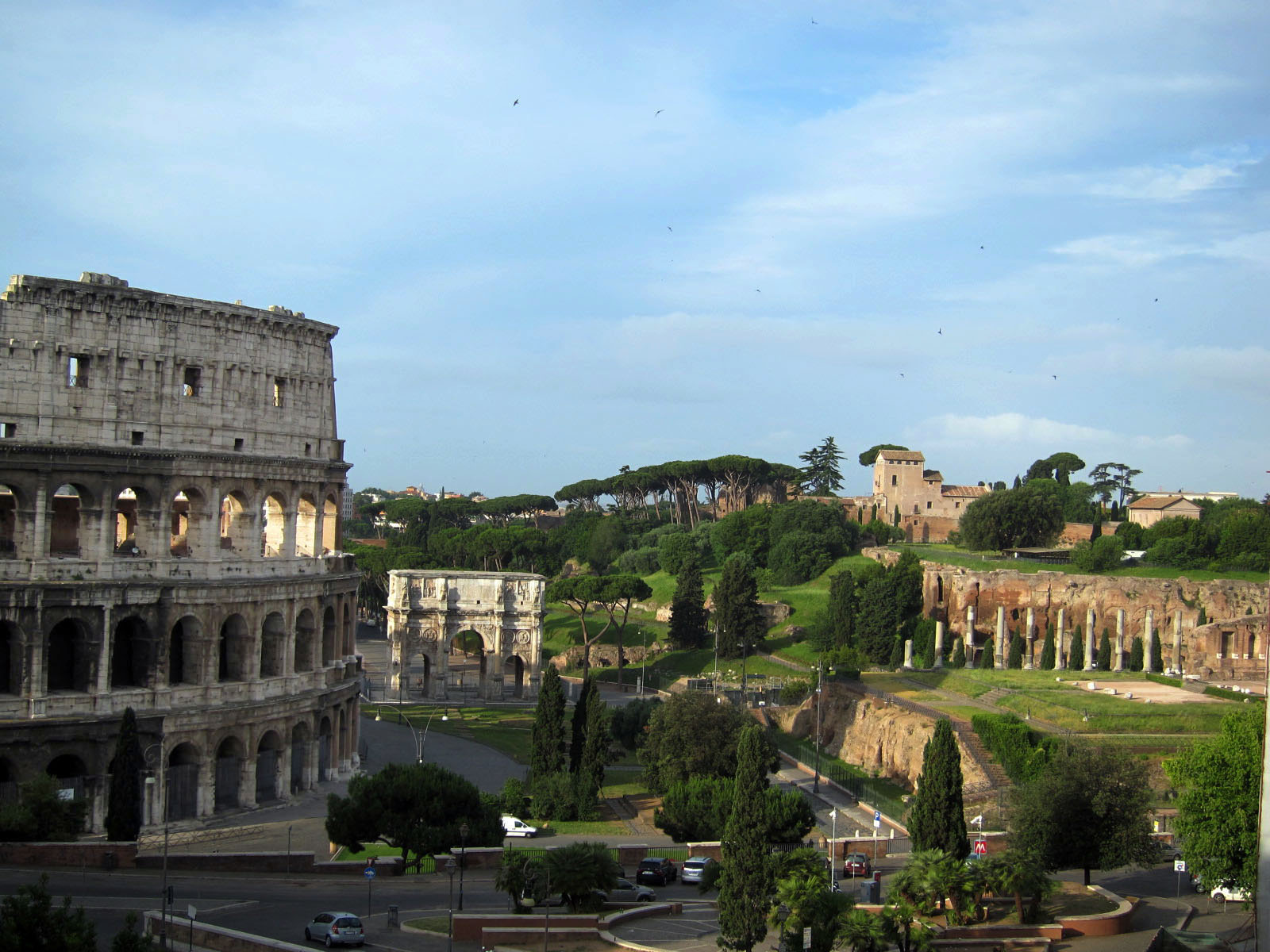 To the right of the Arch are the graceful remains of the Temple of Venus and Rome (Venus e Roma). Venus in Latin is also represented as AMOR (as in the goddess of love). When Hadrian’s built it in the 2nd century, the temple was also called AMOR-ROMA, kind of the first palindrome. The Emperor Hadrian had a great sense of humor.
To the right of the Arch are the graceful remains of the Temple of Venus and Rome (Venus e Roma). Venus in Latin is also represented as AMOR (as in the goddess of love). When Hadrian’s built it in the 2nd century, the temple was also called AMOR-ROMA, kind of the first palindrome. The Emperor Hadrian had a great sense of humor.
From the terrace we’ve seen everything from Centurions attacking tourists with photo opportunities to vendors hawking hats, parasols, laser etched Plexiglas cubes and splatter balls.
We’ve seen religious groups of Buddhists in very uncomfortable footwear climbing up the hill towards the Church of San Pietro in Vincoli and internationals tour groups from almost every country in the World. It’s a tower of Babel out there.
We watched thousands of flag waving Italian football fans on their way to the Circo Massimo to watch the playoff game of the European Football Championship. They lost to Spain by an embarrassing score of 4-0.
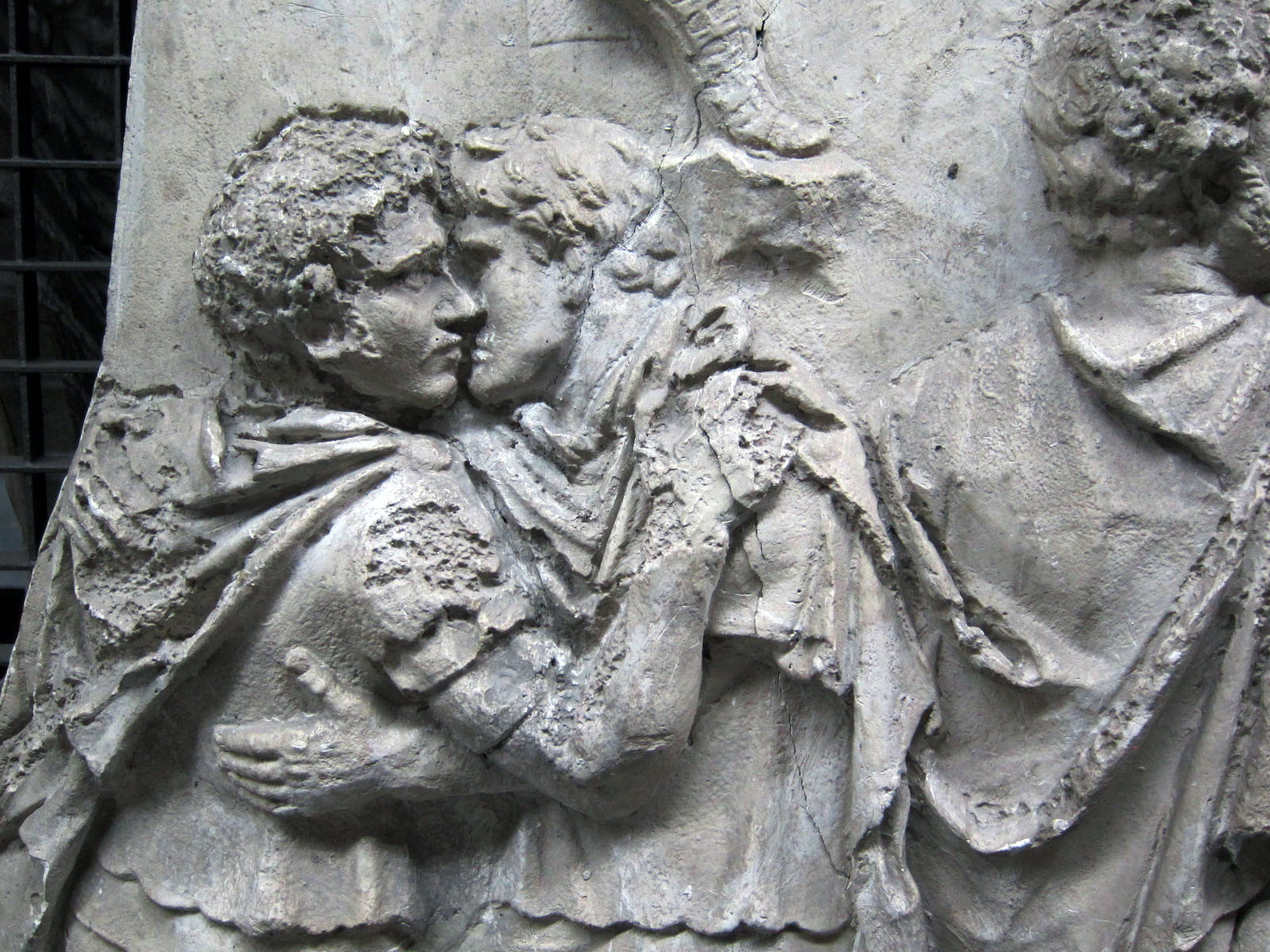 We watched the Gay Pride Parade roll down the Via dei Fori Imperiali. I don’t think this was what Mussolini had in mind when he had the road built in 1931 but it was a lot of fun to watch it from our perch above the Colosseo. The Gay Pride parade came at the same time as Rome’s Gay Village, an annual summer festival with concerts, dance clubs, theatre, costumed contests and probably a lot more. The Gay village has been happening since 2002. The Gay population of Rome is thousands of years old.
We watched the Gay Pride Parade roll down the Via dei Fori Imperiali. I don’t think this was what Mussolini had in mind when he had the road built in 1931 but it was a lot of fun to watch it from our perch above the Colosseo. The Gay Pride parade came at the same time as Rome’s Gay Village, an annual summer festival with concerts, dance clubs, theatre, costumed contests and probably a lot more. The Gay village has been happening since 2002. The Gay population of Rome is thousands of years old.
 And we’ve seen well over 100 brides and grooms posing for their monumental wedding photos. There are at least two every day. On weekends we’ve seen as many as 6 or 7.
And we’ve seen well over 100 brides and grooms posing for their monumental wedding photos. There are at least two every day. On weekends we’ve seen as many as 6 or 7.
The brides look like inverted ice cream cones melting over the hot cobblestones. They float across the pavement almost as if they are levitating a couple of inches off the dirty dusty ground. The dresses are usually white but we have seen a few pink ones. They arrive in large antique cars from Rolls Royce to Bugatti, although the smarter ones come in modern BMWs with air conditioning. The grooms are fashionably head shaved (testa pelata). Some of them dress in black suits, some in tails and top hat.
June wedding have been popular since ancient Rome. Juno was the protector of women and the goddess of abundance and fertility. She is also the ancient Roman goddess of marriage.
The Market of Porta Portese, The Largest Outdoor Sunday Market in Europe
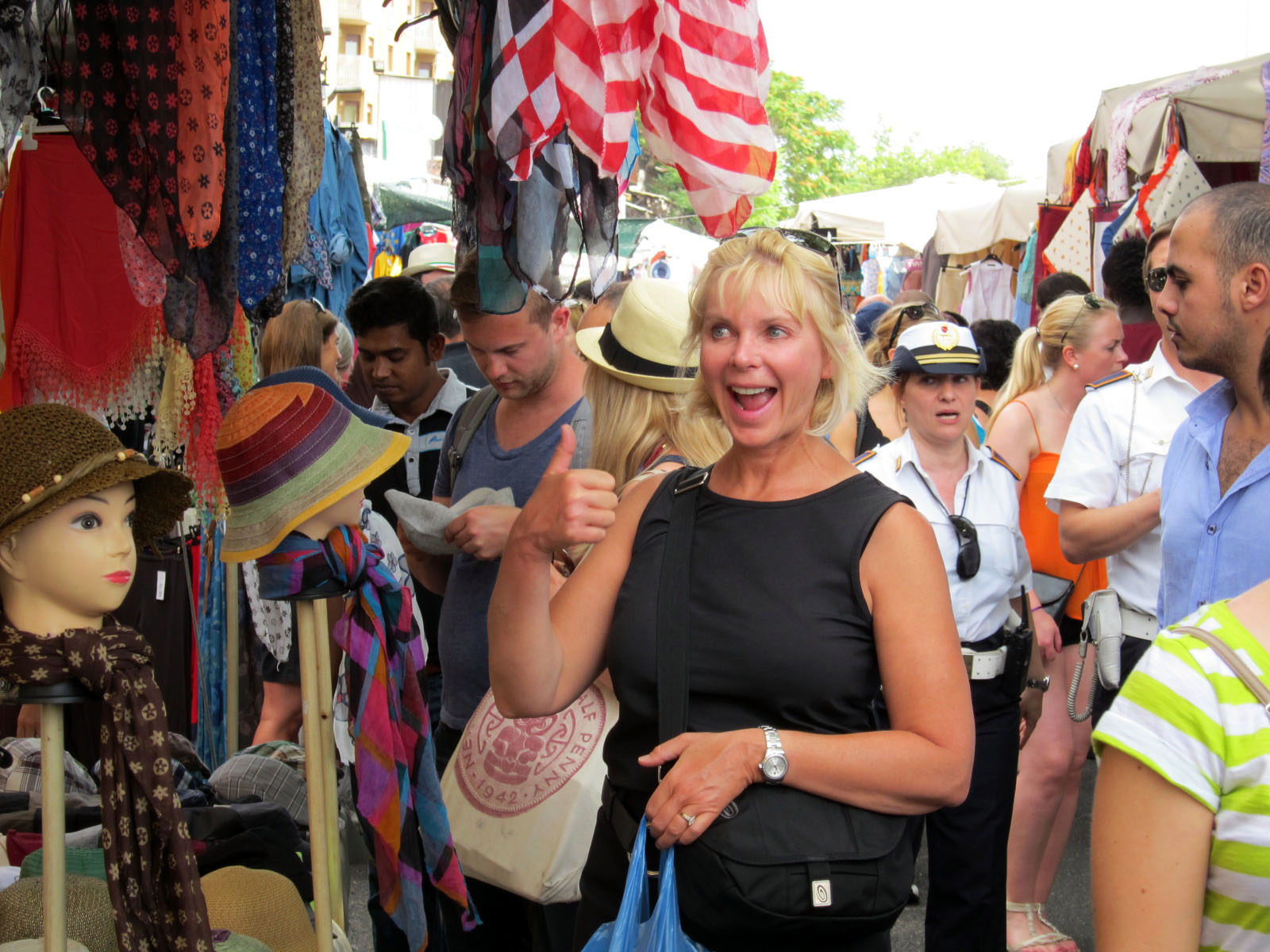 We decided to bypass the small markets for all our household needs and just go for the big haul, Il Grande Mercato di Porta Portese in the Trastevere.
We decided to bypass the small markets for all our household needs and just go for the big haul, Il Grande Mercato di Porta Portese in the Trastevere.
The Porta Portese is one of the gates to the old 17th century fortifications. Now it serves as the entrance to what many have called the largest open air market in Europe, possible the world.
We put our list together, made sure our valuables were protected (Porta Portese is also one of the most famous pickpocket markets in the World) and headed into the fray.
The first mile or so is filled with an endless canopy housewares and knockoff clothing. Gretchen bought a nice Calvin Gucci bag.
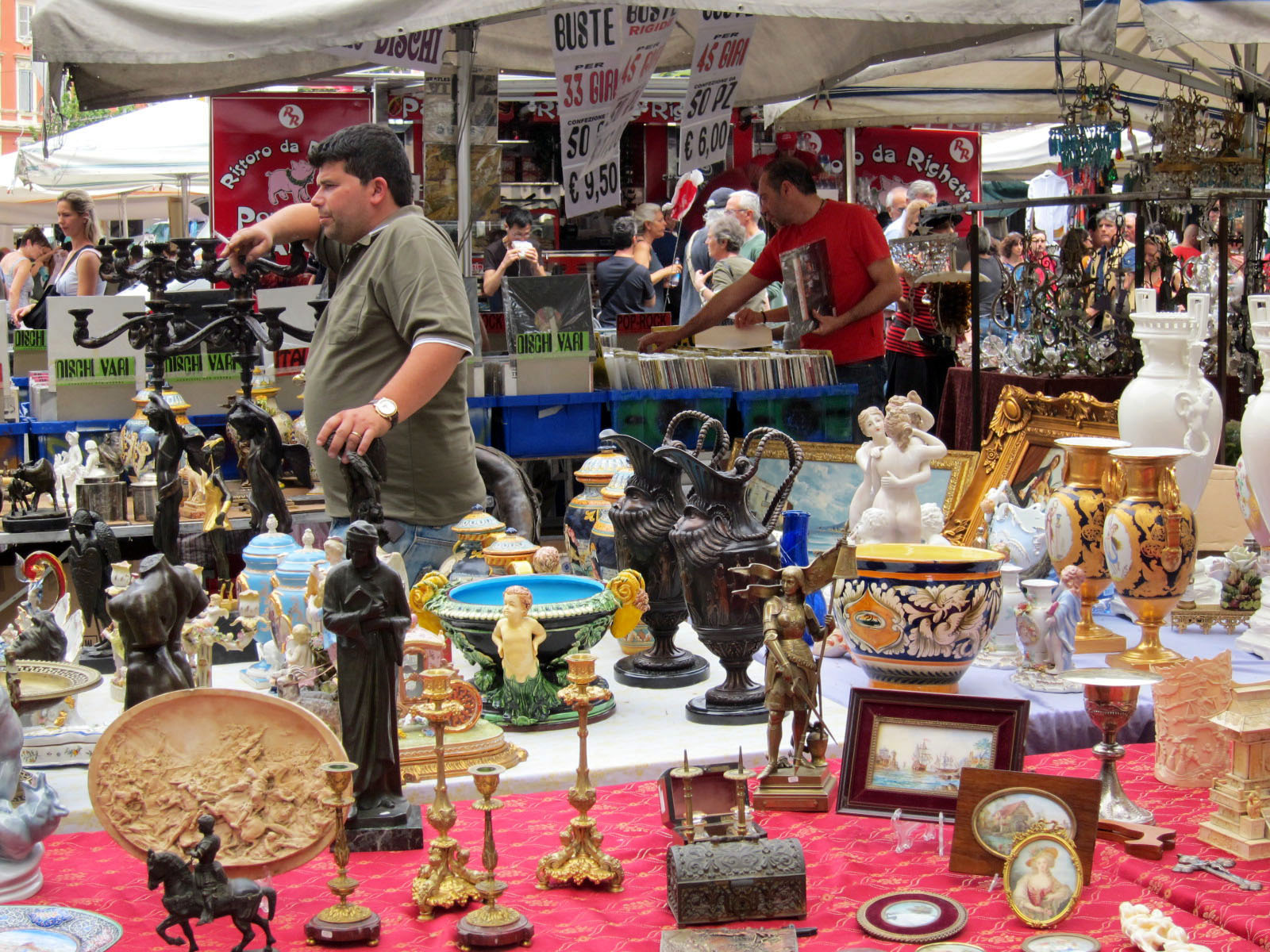 A couple of hours into the madness, the road takes a split and would found ourselves in the actual flea market, filled with antiques (real and fake), memorabilia, jewelry, old records and tons of things we never got to see. After 4hrs we were overloaded. We took our purchases, somehow ended up on Viale di Trastevere (the main artery through the Trastevere) and walked back to our side of the river over the Garibaldi bridge.
A couple of hours into the madness, the road takes a split and would found ourselves in the actual flea market, filled with antiques (real and fake), memorabilia, jewelry, old records and tons of things we never got to see. After 4hrs we were overloaded. We took our purchases, somehow ended up on Viale di Trastevere (the main artery through the Trastevere) and walked back to our side of the river over the Garibaldi bridge.
It was a great experience but once was enough for a while.
Why we like the Rioni Monti, the first district of Rome.
We used to think the center of city was near Piazza Navona, and while this might be true these days, the old Monti district is really the center of the ancient city.
Behind us is the St Pietro in Vincoli Church (also known as the Moses church for Michelangelo’s statue of Moses on his tomb of Pope Julius II). Walk down the steps from the church and cross via Cavour and your in the ancient Roman Suburra, once the home of Roman riff-raff, now filled with chic boutiques and small restaurants.
Down the old Fagutale Hill is the Colosseo and down the via Gregoriana is the Palatine Hill and the old gate that once led to the 16th century Horti Farnesiani (Farnese Gardens), the first private botanical garden in Europe.
A three minute walk away is the Oppian Park, once home to the Baths of Titus , the much larger Baths of Trajan and the enormous Domus Aurea of Nero. Many of the remains are still there.
In our trip to the local Carrefour Supermercato, we walk past the Ludus Magnus, the ancient Gladiator School attached to the Colosseo by underground tunnels. From there it’s a short stroll through the Gay neighborhood and over to the Caelian Hill and down towards the even bigger Baths of Caracalla.
A 10 minute walk down the Via San Giovanni in Laterano brings us to the Basilica of San Clemente with it’s 12th century Basilica on top, the ruins of the 4th century Basilica one level down and the ruins of a 1st century Roman neighborhood below.
We can take the Metro B (blue) line that stops less than 500 ft. from our apartment building. The B line trains are hot and stuffy (no air conditioning) and covered with arrogant tag graffiti, but for it’s a quick and easy way to get around the city. The Metro A (red) line trains are clean, air conditioned and very comfortable. Metro B trains are definitely lower class.
We are minutes from the via dei Fori Imperiali, the road made by Mussolini in 1931 when he cut through the Imperial Fori of Julius Caesar, Augustus, Nerva, Trajan and Vespasian.
We love the via dei Fori Imperiali on Sundays when it’s closed to traffic. There are musicians, street artists and lots of really interesting people walking the grand avenue.
 From the road, the biggest building is the Basilica Nova or Basilica Maxentius, started by the Emperor Maxentius in 308 and finished by the Emperor Constantine in 312 after he finished Maxentius at the battle of the Milvian Bridge.
From the road, the biggest building is the Basilica Nova or Basilica Maxentius, started by the Emperor Maxentius in 308 and finished by the Emperor Constantine in 312 after he finished Maxentius at the battle of the Milvian Bridge.
In the 1960 Olympics in Rome, the wrestling contests were held in the Basilica Nova. 1960 was the same year Cassius Clay won the gold metal for light heavyweight boxing and Rafer Johnson won the Decathlon.
In the Mirabilis Urbae Romana, the 12th century tour-guide, the authors stated that the grand Basilica collapsed on the night Jesus Christ was born. Most of the building did collapse but it was from an earthquake in 847. Then again, it wasn’t even built until 308, some 300 years after Jesus was born. But don’t let that get in the way of a good Christian pilgimage.
Across the Via from the Basilica of Maxentius is a Tourist Center with a small theatre showing an amazing fly through of the ancient city. It’s free and we highly recommend it. It really gives you a good idea of what it all must have looked like.
There are still some interesting churches in the Forum. There used to be more of them but now only a few remain. You need to check the hours to visit but they are usually open on Saturday and Sunday from 10am-12:30pm and again from 4pm – 6:30pm.
The Church of SS Cosma and Damiano is the oldest, built in 527. Pope Felix IV converted a rectangular hall of the library of the Temple of peace into this church. The hall is still attached to the 4th century Temple of Romulus, named for the son of Emperor Maxentius and not the founder of Rome. The current church is 17th century.
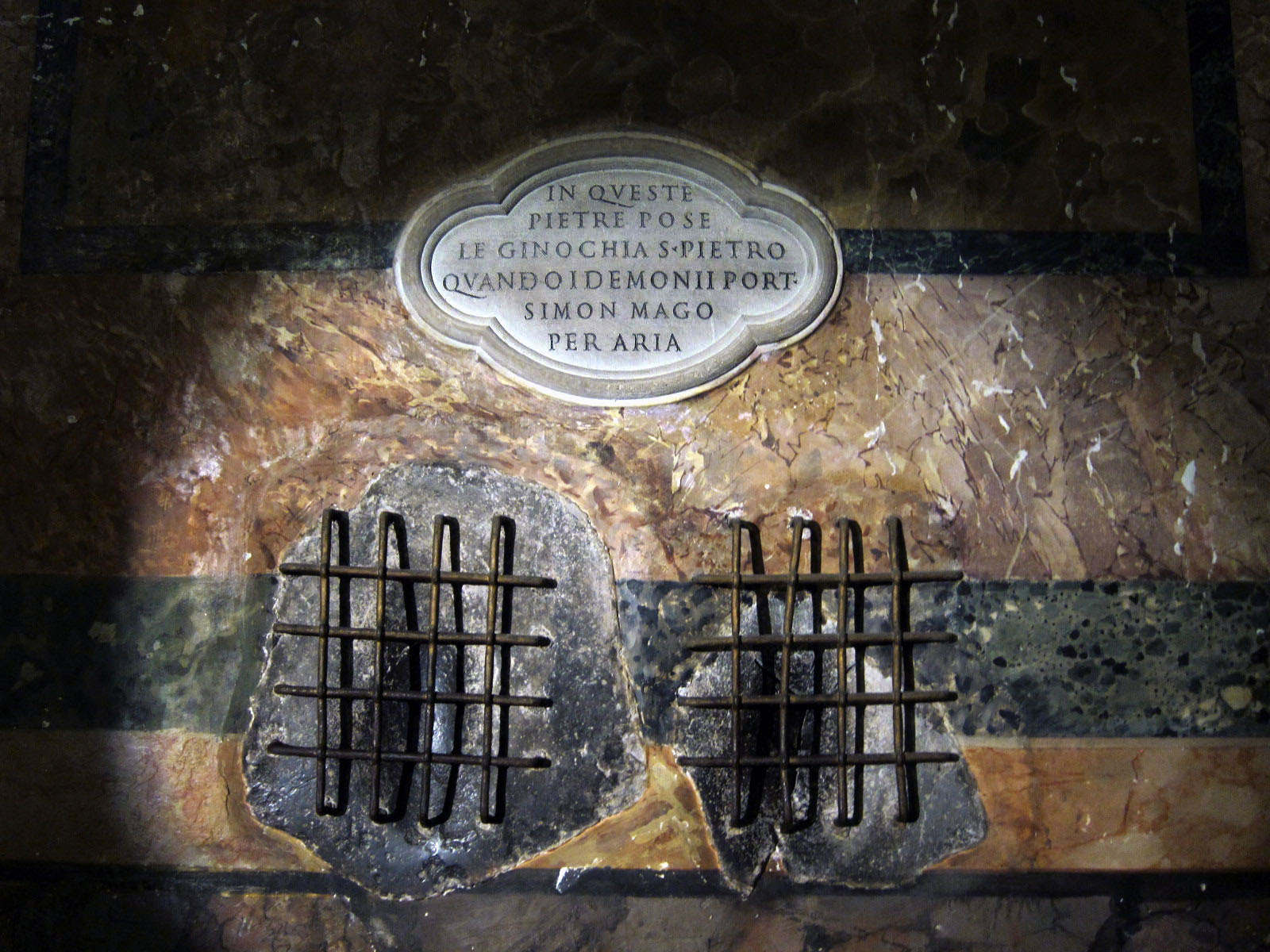 The Santa Francesca Romana Church built into the portico of Hadrian’s temple to Venus and Rome goes back to the 8th century when it called Santa Maria Antiqua, but most of that church collapsed along the way. It became the Church of Santa Francesca Romana in the 17th century.
The Santa Francesca Romana Church built into the portico of Hadrian’s temple to Venus and Rome goes back to the 8th century when it called Santa Maria Antiqua, but most of that church collapsed along the way. It became the Church of Santa Francesca Romana in the 17th century.
The origins of the Church were supposedly built over the knee prints of St Peter. They were dug up from the volcanic basalt stones of the Forum and embedded into the wall of the church. Go to the back, on the right hand side just before you go down to the crypt.
According to the legend, in order to prove to the people of Rome that his powers were greater than Peter’s, Simon Magus, the magician, levitated himself high over the Forum. Peter fell to his knees and prayed to make Simon stop. He prayed so hard his knee prints were embedded into the basalt stones. God answered his prayers and Simon Magus fell to the ground and died. A pretty severe punishment for just levitating over the crowds.
Relics were (and still are) a big draw to the faithful. Bones and artifacts of saints are not only remains to be revered, they are relics of magical powers. Pilgrims come from all over the Christian world to be near them, to pray to them, to touch them. Pilgrims are good business for the Church. More pilgrims equals more money. In the early days of Catholic Rome, bones were brought in by the wagonload and splinters of “holy saints” were given out to the most pious pilgrims.
Rome had (and probably still has) more saintly bones and biblical artifacts than any other place in the world. St Peter was the biggest draw but Rome also had the relics of St Lawrence, St Paul, St Andrew and St Steven.
At one time the city boasted to have the grill where St Lawrence was burned, the chains of St Peter, the knee prints of St Peter, the vat where John the Evangelist was boiled alive, the ivory inlaid chair of St Peter, the “Veronica cloth used by Jesus to wipe his brow on the way to the Cavalry Hill and the true cross brought to Rome by St. Helen.
The St John in Lateran Basilica alone was reported to have the heads of Peter and Paul, the Scala Sancta staircase from the palace of Pontius Pilate where Christ climbed during the passion, the Ark of the Covenant, the rod of Aaron, a portion of the manna Christ fed to the masses, the tablets of the 10 Commandments, John the Baptist’s hair-shirt, some of the milk from the Virgin Mary, a nightgown of the Virgin Mary, the last remnants of the loaves and fishes, a section of the crown of thorns, some of Christ’s blood, the lance of Longinus that pierced the side of Christ while he was on the cross and the post from where the cock crowed three times. This is just a short list. There are lots more.
Relics brought tourists. Tourists brought money. Money made the Popes and Cardinals very wealthy. Wealthy Popes spent money on urban renewal projects which in turn brought in more pilgrims and more tourists.
Porta Maggiore and the Tomb of the Baker
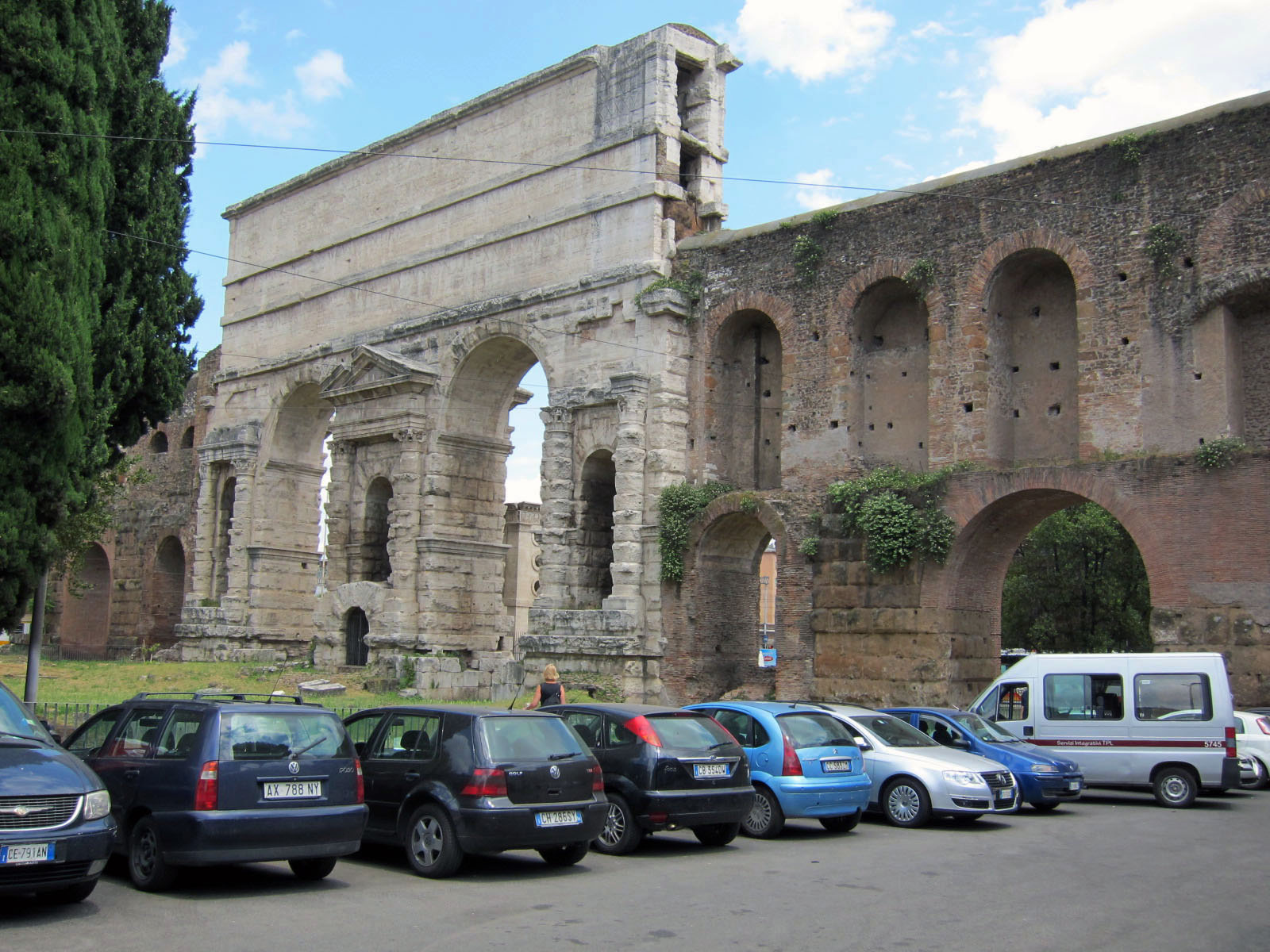 Built in 52AD by the Emperor Claudius, this is not only the best preserved 1st century city gate but also a great example of how the aqueducts were integrated into the city walls. Two sources of water, the Aqua Claudia and the Anio Novus both ran through this arch. The gate was originally built as a decoration to support the two water sources but in 271 it was incorporated into the Aurelian Wall fortifications. The columns holding up the pediment looked eroded by time, but according to Yale Art Historian Diana E. E. Kleiner they were created this way back in the 1st century as a design choice by Claudius. It was kind of modern art of the 1st century.
Built in 52AD by the Emperor Claudius, this is not only the best preserved 1st century city gate but also a great example of how the aqueducts were integrated into the city walls. Two sources of water, the Aqua Claudia and the Anio Novus both ran through this arch. The gate was originally built as a decoration to support the two water sources but in 271 it was incorporated into the Aurelian Wall fortifications. The columns holding up the pediment looked eroded by time, but according to Yale Art Historian Diana E. E. Kleiner they were created this way back in the 1st century as a design choice by Claudius. It was kind of modern art of the 1st century.
Over the years the arch was restored by Vespasian and then Titus. The Latin inscriptions on the attic of the arch are testimonies by Claudius, Vespasian and Titus on how they built and repaired the arch with their own money.
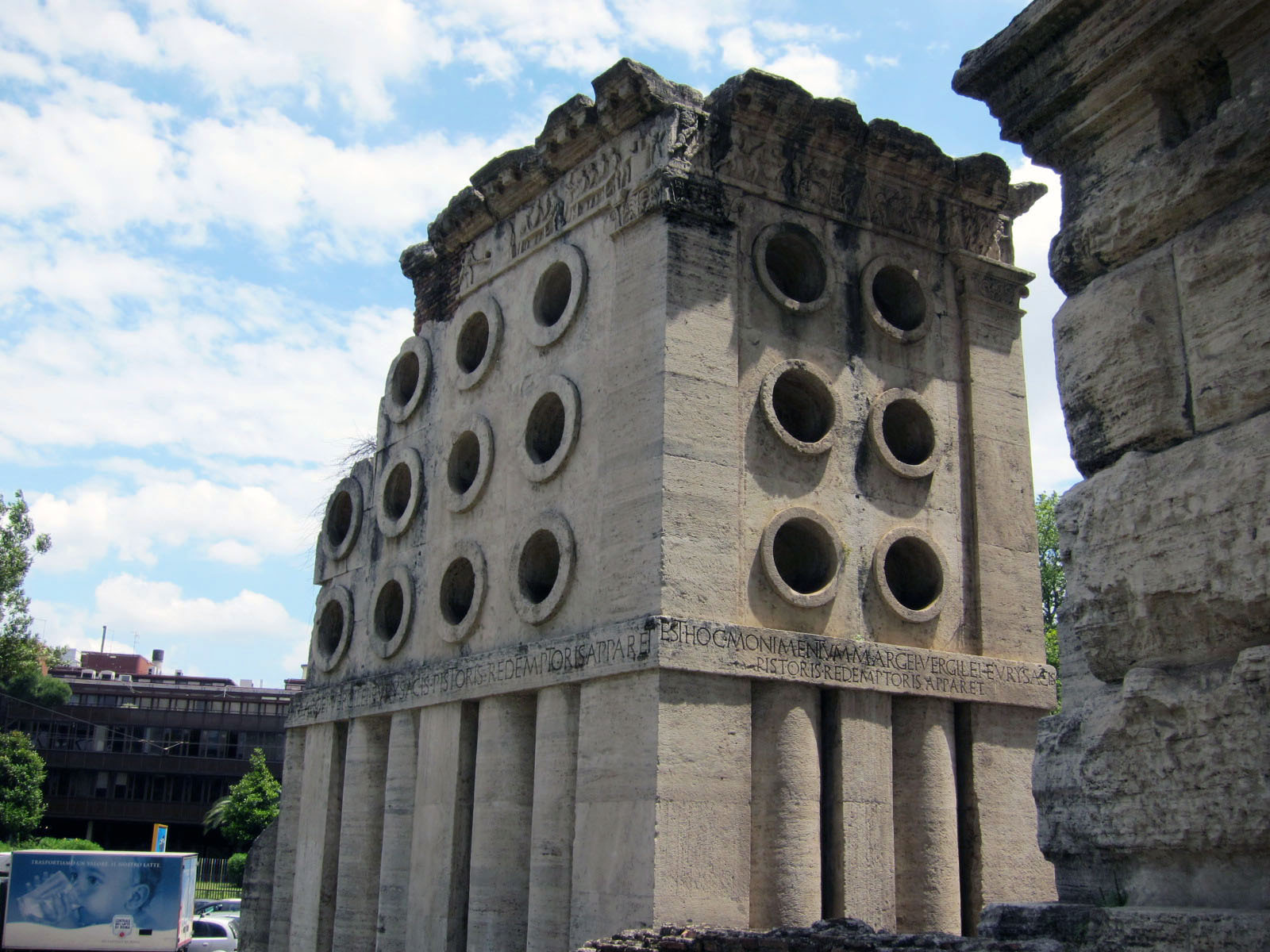 Behind the arch is the “Tomb of the Baker”, the burial tomb of Marcus Virgilius Eurysaces , a former slave who became a freeman and then a very wealthy baker. He built it for himself and his wife, Atistia sometime between 50BC and 20BC. Even though it sits next to the Porta Maggiore, it predates the arch by close to 100 years. This (along with the Pyramid of Cestius at Porta San Paolo) is one of the best preserved funerary monuments of ancient Rome.
Behind the arch is the “Tomb of the Baker”, the burial tomb of Marcus Virgilius Eurysaces , a former slave who became a freeman and then a very wealthy baker. He built it for himself and his wife, Atistia sometime between 50BC and 20BC. Even though it sits next to the Porta Maggiore, it predates the arch by close to 100 years. This (along with the Pyramid of Cestius at Porta San Paolo) is one of the best preserved funerary monuments of ancient Rome.
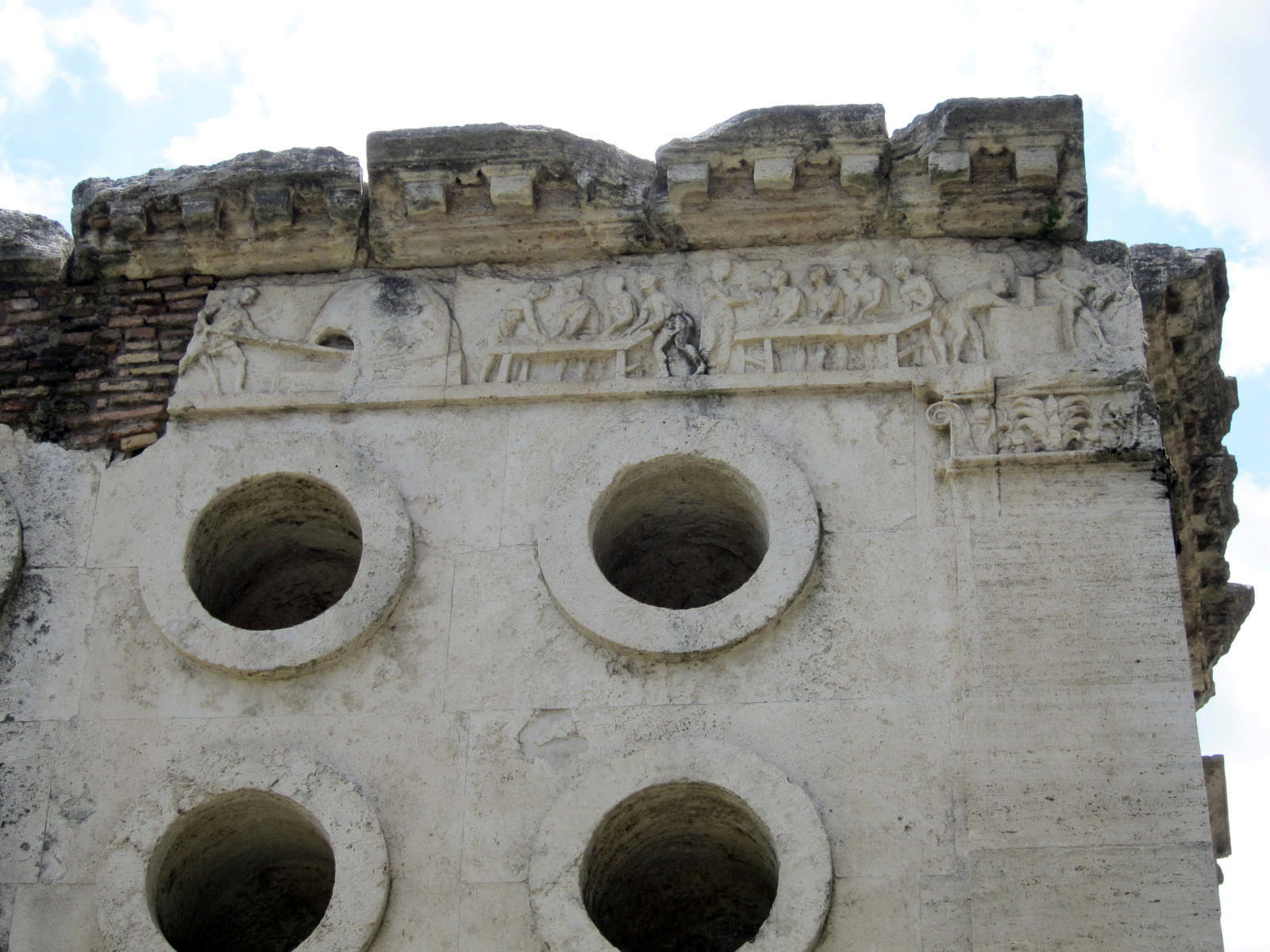 We pretty much know he was a baker thanks to the relief carving that runs around the top of the tomb that shows, grinding the grain and sifting the flour, mixing and kneading the dough, forming the bread into loaves, baking the loaves and putting the baked goods into baskets to take to the market.
We pretty much know he was a baker thanks to the relief carving that runs around the top of the tomb that shows, grinding the grain and sifting the flour, mixing and kneading the dough, forming the bread into loaves, baking the loaves and putting the baked goods into baskets to take to the market.
The cylinders on the sides of the tomb could either represent a measure of grain or possible the shape of an ancient kneading bowl.
Porta Maggiore is also one of the best places to see a good long stretch of the 2nd century the Aurelian Walls. You can really get an idea of how the walls and the aqueducts were incorporated into the architecture of the city.
The Baths of Diocletian and the 3 day museum pass
I read that in the courtyard of the Santa Maria degli Angeli church are two large heads that once sat in the temple of Trajan, which once sat behind Trajan’s tower. Our goal of the day was to find them.
The Basilica of Santa Maria degli Angeli was created from the ruins of the great 4th century Diocletian baths that could service over 3,000 people at a time. They were built just inside the ancient Servian Walls which were built under the rule of Servius Tillius, the 6th king of Rome during the 6th century BC.
Servius was killed by an order given from Tarquinius Superbus, who became the last king of Rome, giving way to the Roman Republic.
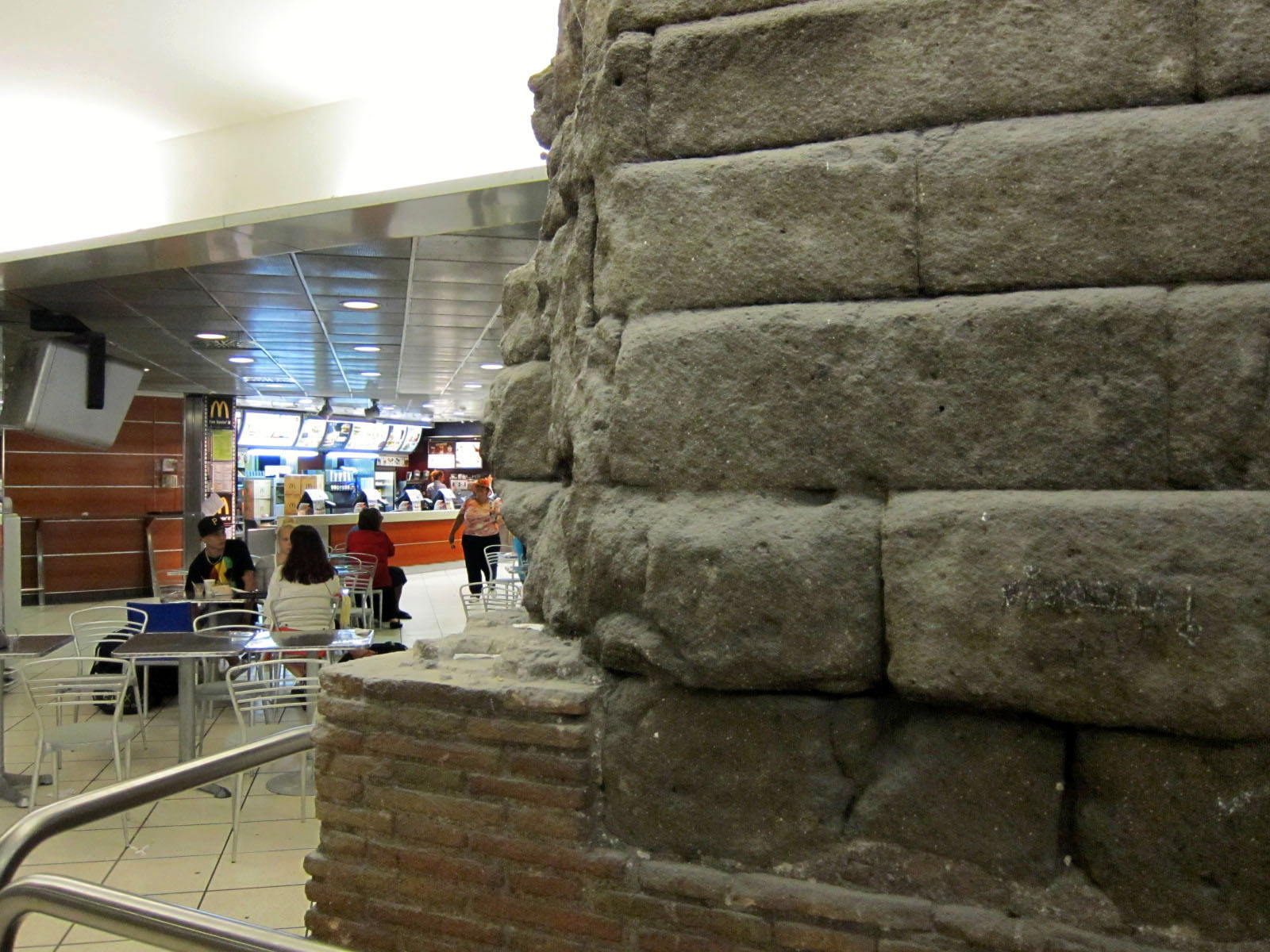 In its day it was 133’ tall and 12’wide and believed to be over 7 miles long with 16 gates. It greatest achievement was when it held off Hannibal in 211 BC during the second Punic wall. He looked at it and decided it wasn’t worth the effort.
In its day it was 133’ tall and 12’wide and believed to be over 7 miles long with 16 gates. It greatest achievement was when it held off Hannibal in 211 BC during the second Punic wall. He looked at it and decided it wasn’t worth the effort.
The best remaining section of the Servian Wall is just outside the Termini train station although there is another section inside the McDonalds restaurant in the station.
The ruins of the Baths of Diocletian stretch all across the Piazza Della Repubblica to the train station.
The Santa Maria degli Angeli Basilica occupies what was the small round tepidarium (warm room) and the large frigidarium (large cold swimming pool). It was redesigned into the church by Michelangelo in the 1560’s and “improved” by Luigi Vanivelli in the 18th century. Michelangelo tried to keep much of the frigidarium in place and many of the columns and floor tiles are original. When you stand inside and think of this enormous room as a cool swimming pool, you really get a feeling of the size of the Baths.
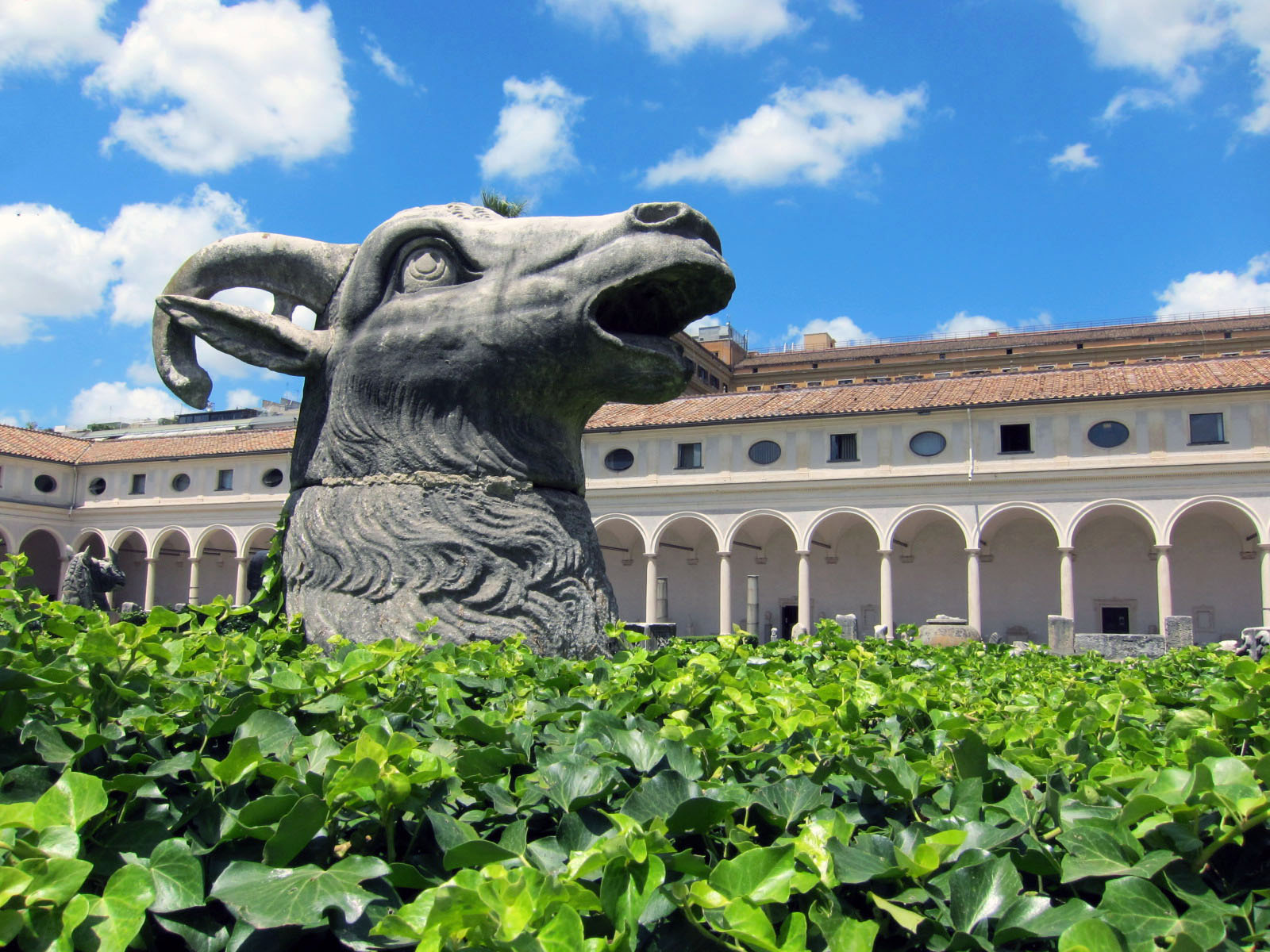 We tried to get into the courtyard but it turned out there was no entrance to it from the church. We had to buy a ticket to the Baths of Diocletian Museum around the corner. No problem. Getting inside the old baths was well worth the ticket. The heads are in the Cloister, also built by Michelangelo. Although it is all very harmonious, the big heads do overpower the harmony. Two of them are ancient, the rest of them are copies made much later on.
We tried to get into the courtyard but it turned out there was no entrance to it from the church. We had to buy a ticket to the Baths of Diocletian Museum around the corner. No problem. Getting inside the old baths was well worth the ticket. The heads are in the Cloister, also built by Michelangelo. Although it is all very harmonious, the big heads do overpower the harmony. Two of them are ancient, the rest of them are copies made much later on.
The baths of Diocletian museum is really well laid out showing artifacts from every part of daily life in ancient Rome. The grand piece de resistance is at the end when you are allowed into the “Aula”, one of the ancient halls. It’s big. The Romans had no qualms about building big. There are few ancient halls that still have roofs intact. This is one of them.
All of the ancient Roman architecture was based on round numbers based on the roman foot. The Romans (following the Greek Philosophers) believed 10 to be the perfect number and consequently the forum and most of the Roman public buildings were constructed using multiples of 10. The roman foot by the way was 11.7” or 29.6 centimeters, very close to the measurement we still use today. It was also divided into 12 unica from where we get our inches. The Roman foot was introduced to Britain in the 1st century. Britain moved over to the metric system in 1969. In America, we still adhere to the old Roman form of measurement.
Its amazing how far we haven’t come.
The ticket to the Baths of Diocletian Museum is good for 3 days and also includes admission to the Palazzo Massimo by the train station, the 16th century Palazzo Altemps, and the Crypta Balbi, a medieval museum with the ruins of the 1st century BC theatre of ruins of the ancient theatre of Lucius Cornelius Balbus, a General under Julius Ceasar. It’s one of the best museum deals in Rome.
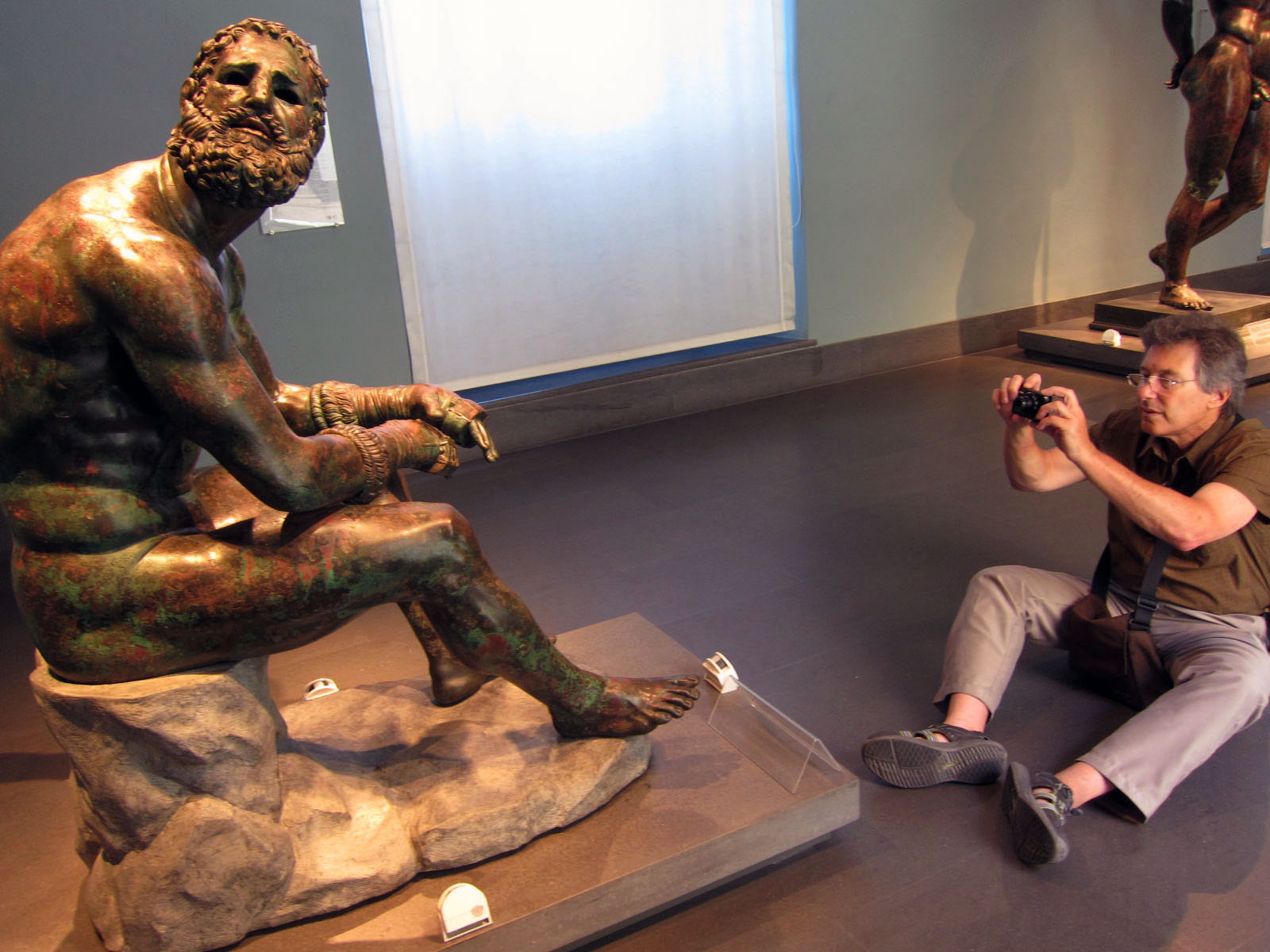 The Palazzo Massimo al Terme is another great collection of ancient Rome from the Republican period through the late Imperial Empire. Thehighlights are the frescoed walls from the villa of Livia, the wife of Augustus, discovered in 1863 under via Flaminia (near Piazza del Popolo). Frescoed between 30-20 BC, it is the oldest continuous painted garden in existence. There is even a lighting effect to show how the frescoed walls would appear to the guests at various times of the day.
The Palazzo Massimo al Terme is another great collection of ancient Rome from the Republican period through the late Imperial Empire. Thehighlights are the frescoed walls from the villa of Livia, the wife of Augustus, discovered in 1863 under via Flaminia (near Piazza del Popolo). Frescoed between 30-20 BC, it is the oldest continuous painted garden in existence. There is even a lighting effect to show how the frescoed walls would appear to the guests at various times of the day.
In another room is the bronze statue of the Boxer (Greek from around 330 BC) that were found in the baths of Constantine (now the Quirinale Palace). It’s in perfect condition right down to the scars etched into his face.
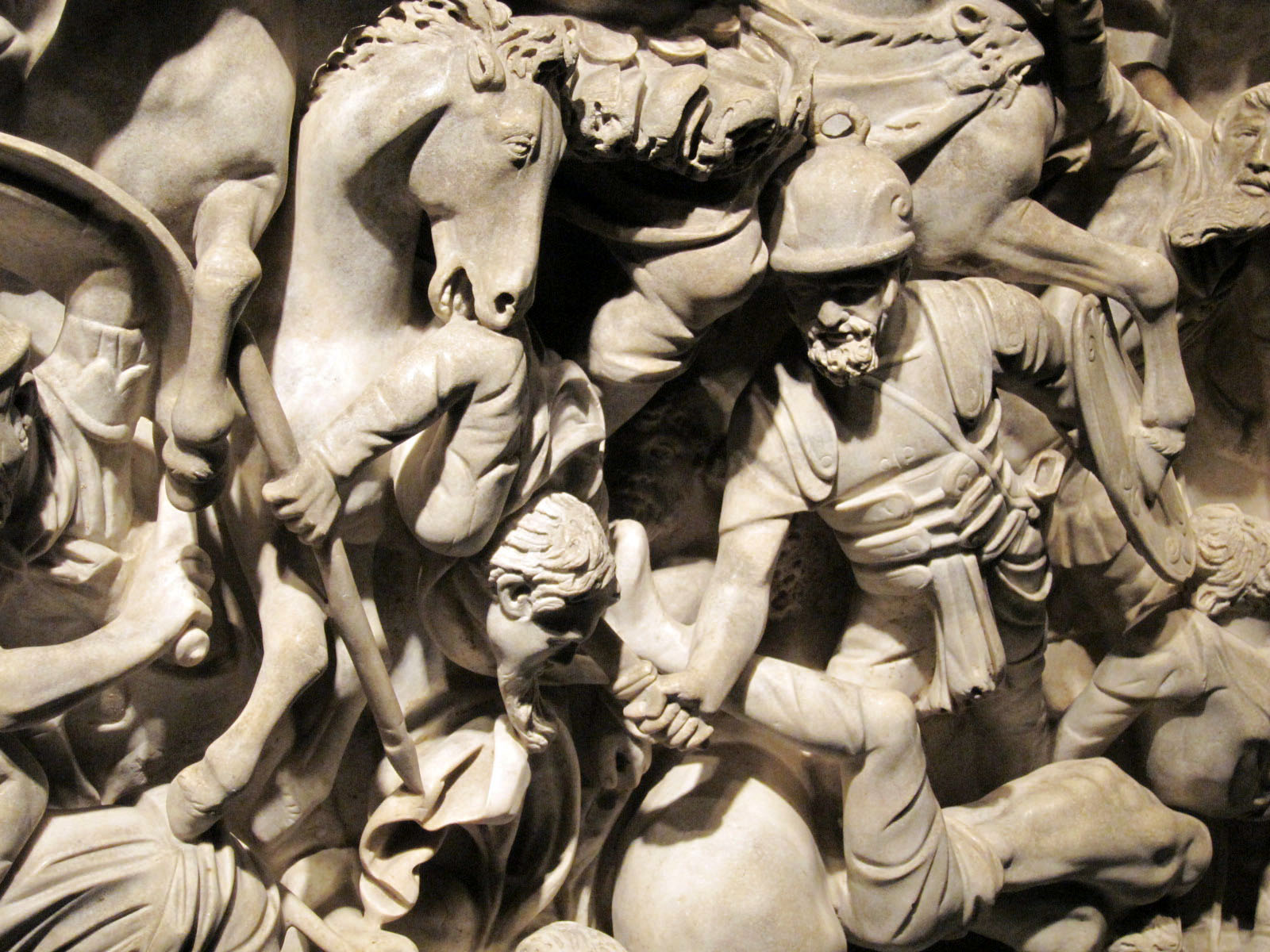 Another great piece is thePortonaccio Sarcophagus(discovered in the Portonaccio quarter of Rome in 1931). It was built for a General under Marcus Aurelius around 180 AD. It has amazing carved reliefs telling the story of his campaigns in the same style as the column of Marcus Aurelius in Piazza Colona.
Another great piece is thePortonaccio Sarcophagus(discovered in the Portonaccio quarter of Rome in 1931). It was built for a General under Marcus Aurelius around 180 AD. It has amazing carved reliefs telling the story of his campaigns in the same style as the column of Marcus Aurelius in Piazza Colona.
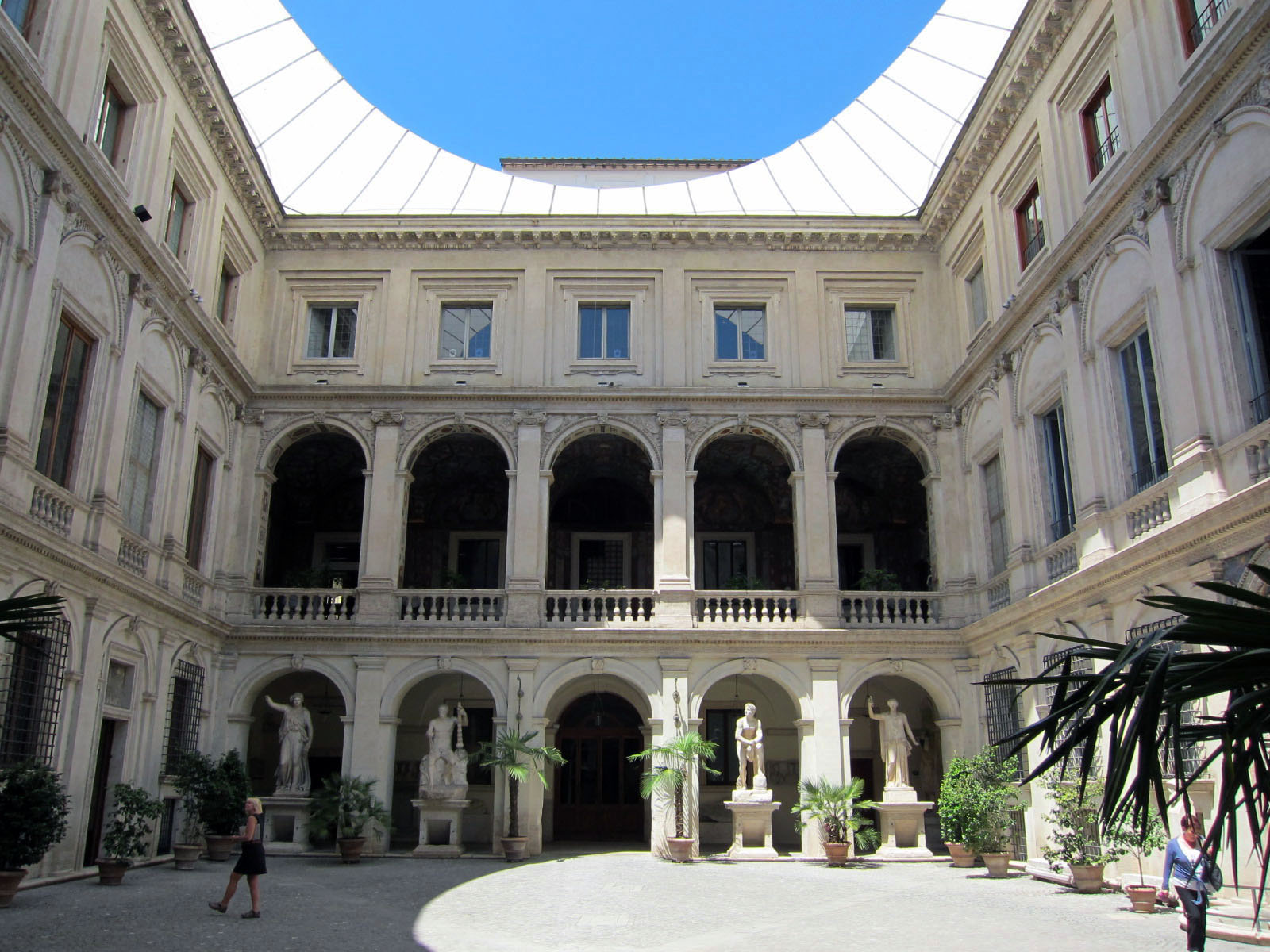 The Palazzo Altemps is a 15th century Palazzo with the private art collection of the Altemps family. The Palazzo was built in the 1477 for Girolamo Riario. One of the Pazzi conspirators convicted of attempting to kill Lorenzo and Giuliano de Medici (they did succeed in killing Giuliano but Lorenzo escaped). Riario was never killed for his involvement in the crime. He had too many friends in the Vatican. However, he was assassinated 4 years later by the Orsi family. There is still a plaque in the Palazzo commemorating the marriage of Girolamo to Catherine Sforza. Eventually the palazzo was sold to Austrian Cardinal Marco Sittico Altemps, the nephew of Pope Pius IV, Giovanni Angelo Medici, a cousin of the Florence Medici family who Riario tried to destroy.
The Palazzo Altemps is a 15th century Palazzo with the private art collection of the Altemps family. The Palazzo was built in the 1477 for Girolamo Riario. One of the Pazzi conspirators convicted of attempting to kill Lorenzo and Giuliano de Medici (they did succeed in killing Giuliano but Lorenzo escaped). Riario was never killed for his involvement in the crime. He had too many friends in the Vatican. However, he was assassinated 4 years later by the Orsi family. There is still a plaque in the Palazzo commemorating the marriage of Girolamo to Catherine Sforza. Eventually the palazzo was sold to Austrian Cardinal Marco Sittico Altemps, the nephew of Pope Pius IV, Giovanni Angelo Medici, a cousin of the Florence Medici family who Riario tried to destroy.
The most interesting (and most famous) piece in the collection is the “Ludovisi Gaul” of a man killing himself and his wife. It is a Roman copy of a 3rd century BC Greek sculpture from the same period as “Dying Gaul” in the Capitoline museum.
 Santa Croce in Gerusalemme and the Villa of Helen and Constantine
Santa Croce in Gerusalemme and the Villa of Helen and Constantine
The Basilica of Santa Croce in Gerusalemme is near the San Giovanni in Lateranno.
Helen took over the Palazzo Sessoriano and had build a small chapel on the property to house the “True Cross” after she brought it Rome.
The Palazzo Sessoriano was started by the Emperor Septimius Severus at the beginning of the 3rd century. By the time Helen moved in it was the 4th century and the Palazzo was already incorporated into the Aurelian walls. The private hippodrome race track and 288’ x 249’ brick Castrense amphitheater were torn apart and became part of the city fortifications. Helen didn’t care about horse racing or private gladiator games. She was just hell bent on making believe what she believed. Lucky for her, her son was the Emperor.
The Basilica of Santa Croce in Gerusalemme has grown considerably since the 4th century and its now one of the “Seven sacred Churches of Rome”. And with this kind of distinction, there have to be relics to back it up.
Inside the Basilica are three small fragments of the true cross. Also on display is a piece of the “Good Thief’s Cross”, part of the index finger of St Thomas (known as doubting Thomas), fragments of the column where Christ was beaten, Christ’s tomb and the crib of baby Jesus.
These days, you can still see the bulge of the Castrense Amphitheatre in the remains of the Aurelian wall. The hemispheric walls inside the grounds of the Basilica of Santa Croce in Gerusalemme are now part of a vegetable and herb garden.
A walk to the Cloaca Maximus
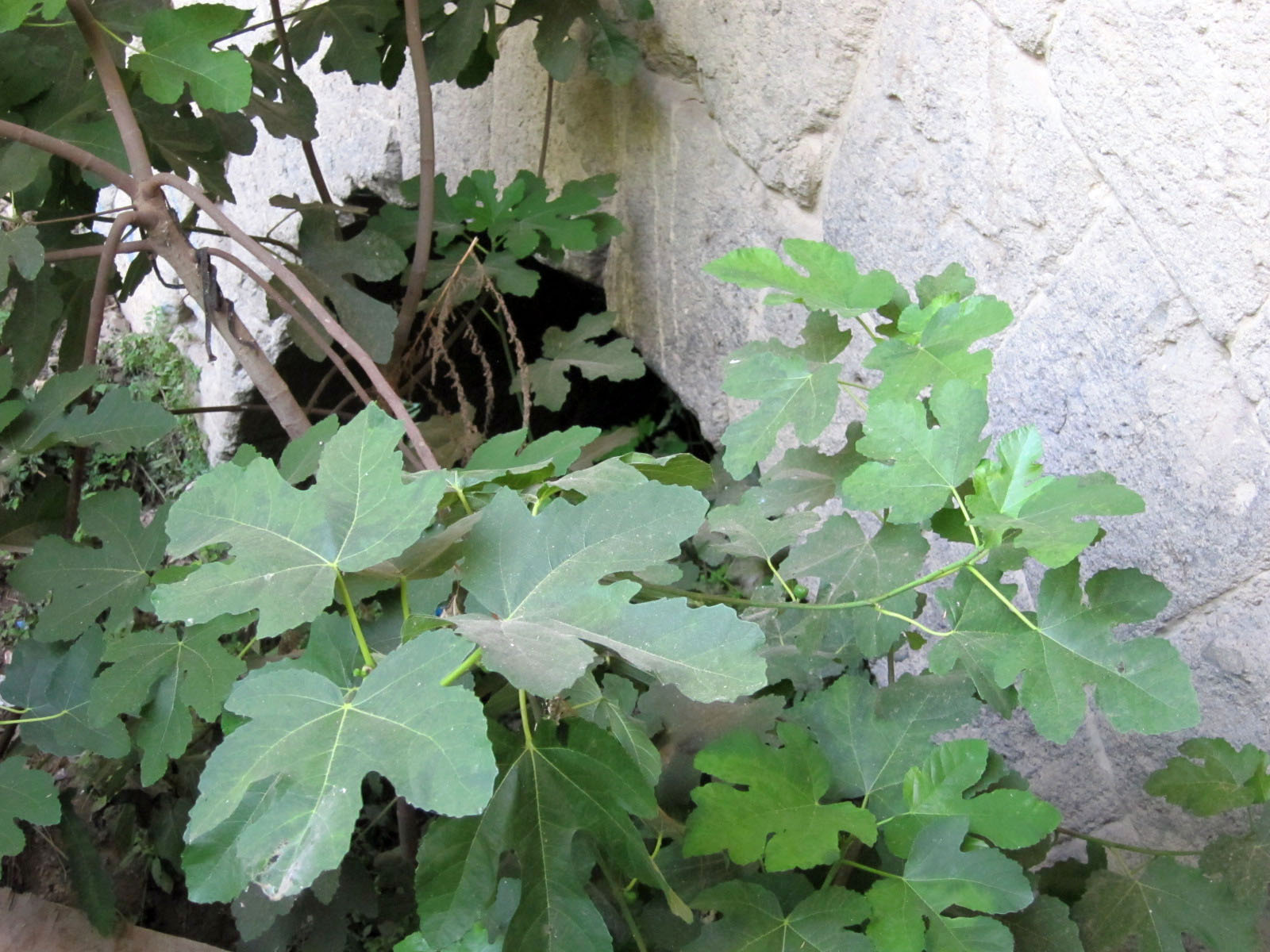 The Cloaca Maximus, the great sewer of Rome was started by Tarquinius Superbus, the last King of the Rome.
The Cloaca Maximus, the great sewer of Rome was started by Tarquinius Superbus, the last King of the Rome.
Pliny, the elder referred to it as the “most wonderful achievement of all time.”
Building a sewer to remove all the waste from Rome was a great achievement. Dumping it into the River next to you city might not have been such a great achievement.
It’s still visible, set in the embankment just below the Ponte Palatino, framed inside a circle of travertine stone. There are a few trees blocking the view but it’s still there and it still works. It looks like someone has taken up residency next to it so we were careful not to disturb the homemade shelter too much.
Near the Ponte Sublicio, the next bridge down the river are a few remnants of the old Porticus Amelia, one of the Roman ports of commerce. A large concrete warehouse once stood there measuring about 1600 ft. long x 295 ft. wide. Roman concrete, (volcanic sand, lime and rubble) was one of the greatest developments of the Roman empire.
 We thought about finding some of the remains of the Porticus Amelia but instead turned the other way and walked under the Ponte Rotto, the 2nd century stone bridge that once spanned the Tevere connecting the Forum Boarium (now Santa Maria in Cosmedin) to Trastevere (now Trastevere).
We thought about finding some of the remains of the Porticus Amelia but instead turned the other way and walked under the Ponte Rotto, the 2nd century stone bridge that once spanned the Tevere connecting the Forum Boarium (now Santa Maria in Cosmedin) to Trastevere (now Trastevere).
There is only one span of the bridge remaining. In 1598 most of it was carried away in a flood.
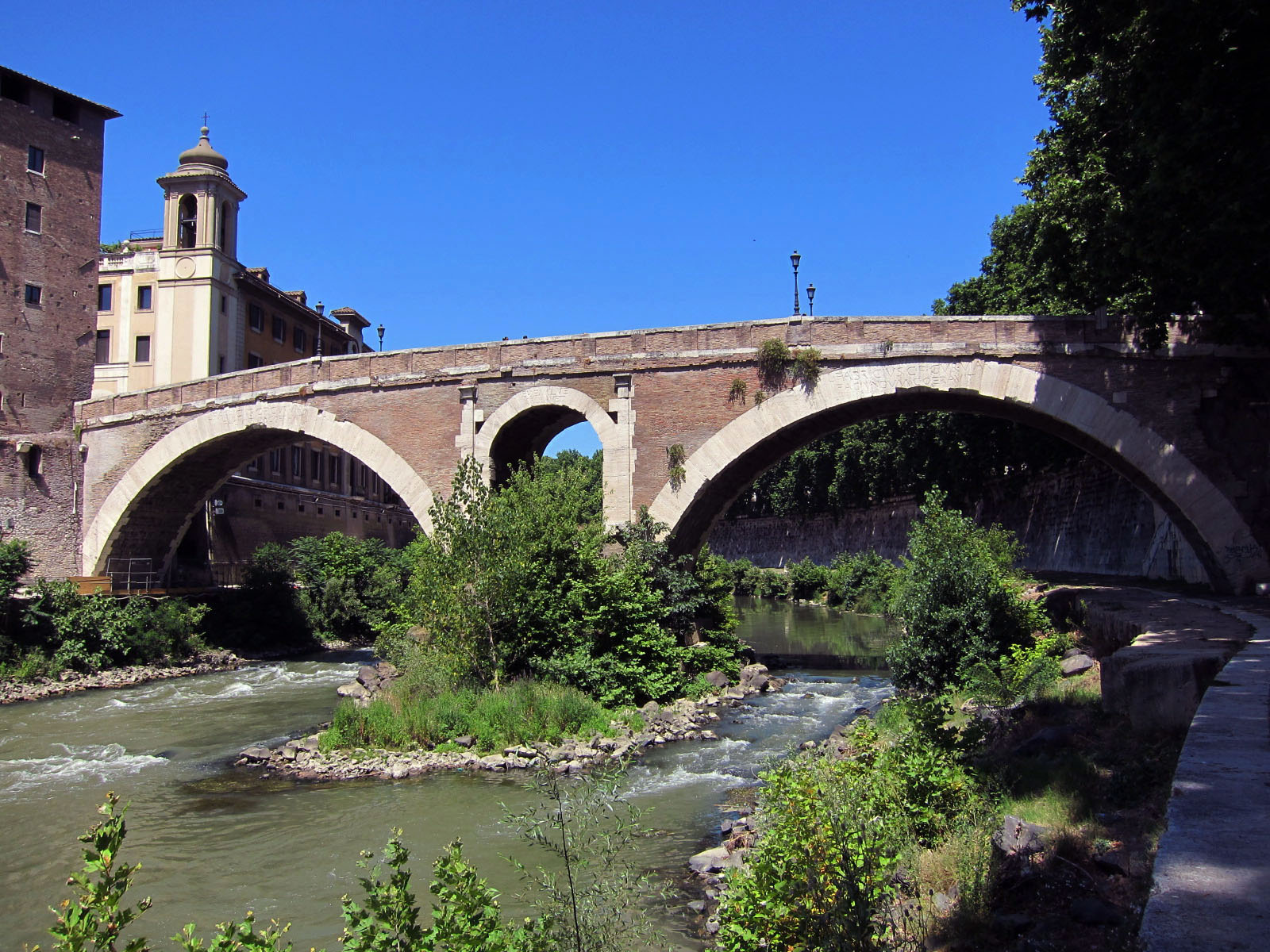 The honor of the oldest bridge in Rome is just a bit up the river. The Ponte Fabricius, built in 62BC, was named for Lucius Fabricius, a city officer in charge of the maintenance of the streets. The bridge is over 2050 years old and it is still in great shape. It goes half way across the river to the east side of island of Tiburtina.
The honor of the oldest bridge in Rome is just a bit up the river. The Ponte Fabricius, built in 62BC, was named for Lucius Fabricius, a city officer in charge of the maintenance of the streets. The bridge is over 2050 years old and it is still in great shape. It goes half way across the river to the east side of island of Tiburtina.
On the west side (from Tiburtina island to Trastevere) is the other ancient Roman bridge, the Cestius Bridge, built in the later half of the 1st century. Lucius Cestius, a city administrator, was the brother of Gaius Cestius who built the amazing pyramid tomb that still sits next to the Porto San Paolo.
Museo della civilta Romana in EUR
EUR was created by Mussolini in the 1930s for the Esposizione Universale Roma that never happened.
It a direct shot on the Metro B line from our stop at the Colosseo and there is an amazing museum of Roman history and civilization, the Museo della Civiltà Romana.
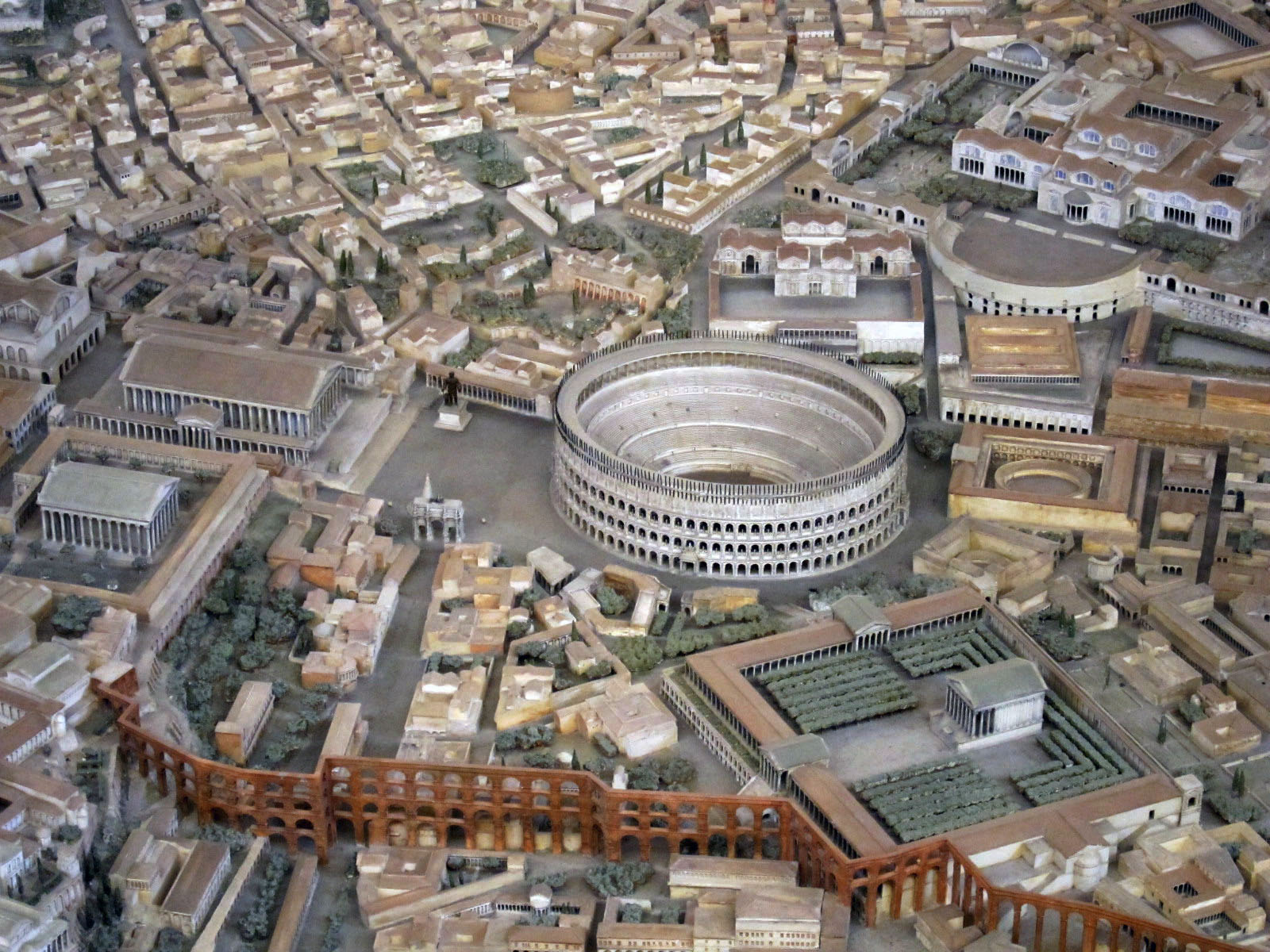 The big prize here is “Il Plastico”, the plaster scale model of the Rome of the 4th century AD at the time of Constantine.
The big prize here is “Il Plastico”, the plaster scale model of the Rome of the 4th century AD at the time of Constantine.
It was recreated from fragments of a marble map known as the Forma Ubris Romae that was discovered under the rubble of the Temple of Peace. The map was created at the time of Septimius Severus, in the 3rd century. According to the size of the fragments, archeologists determined the map scale to be 1:240. Estimating the size to be 60’ wide x 45h and assembled with 150 carved marble slabs mounted onto the interior wall of the Temple of Peace.
The original Forma Ubris Romae was the most complete map of Rome ever created. Unfortunately, most of it was destroyed during the middle ages and used for building materials.
The few remaining fragments started showing up again around 1562 near the SS. Cosma e Damiano. Since then about 10% of the Forma has been rediscovered.
Il Plastico was constructed between 1935 and 1971, by Italian architect and historian Italo Gismondi. He died three years after it was completed.
The scale is 1:250, a little smaller than the Forma Ubris Romae would have been, but Il Plastico is also a map of Rome at a later date, possibly 100 years later. A lot happened to Rome in those 100 years.
Much of Il Plastico is based on information pulled from the 10% of the Forma Ubris Romae fragments. The rest is all archeological and historical conjecture.
You can’t get too close to the map but there is a really good 360° view as you walk around a balcony overlooking the replica. You can clearly see the temples, the baths, the basilicas, the aqueducts. After playing around in the ruins for a while, it’s really fun to see how once upon a time it all came together. It was the most beautiful city in the world.
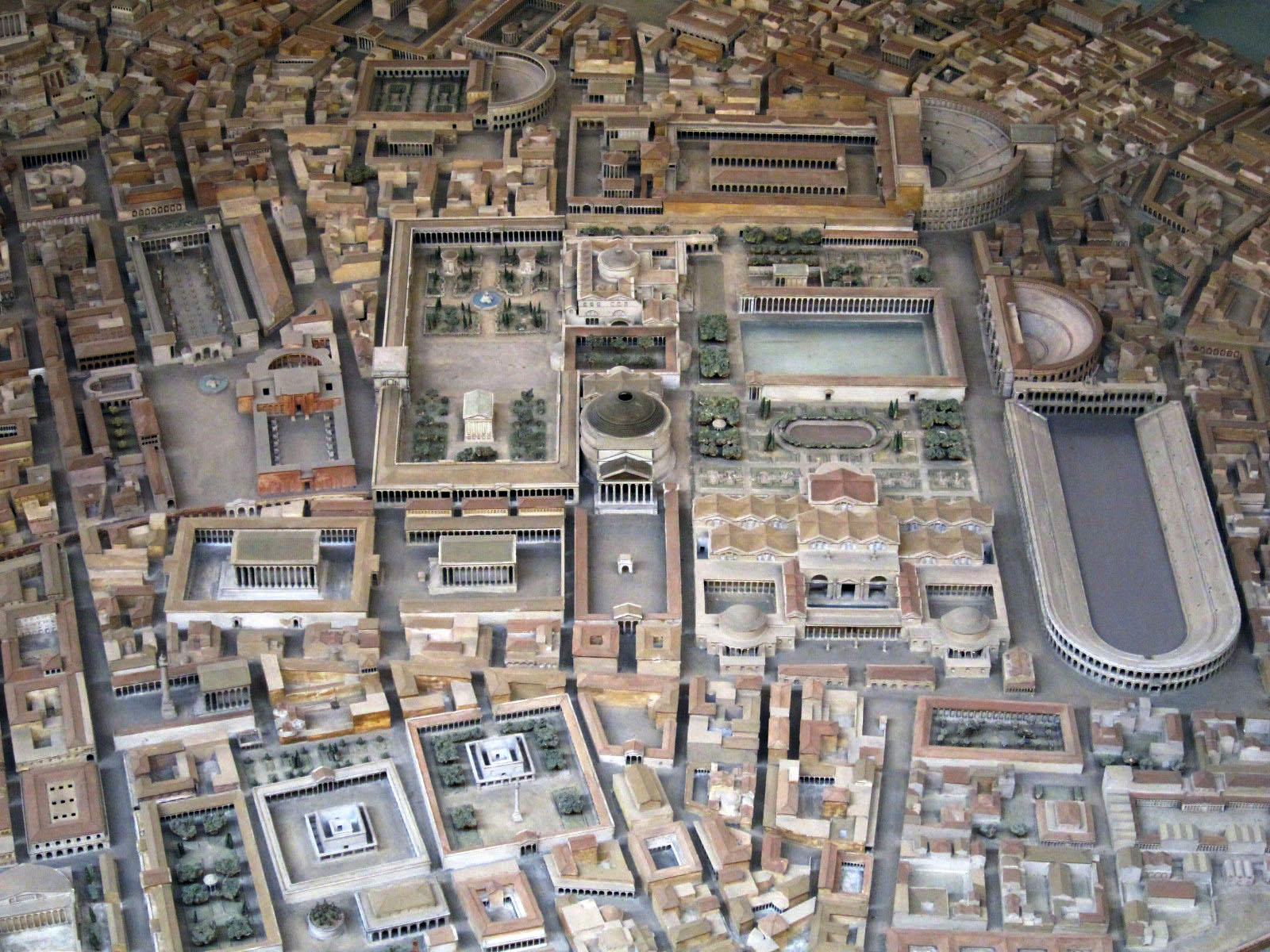 At the beginning of the rule of Constantine in 306, Rome was a city of 1.6 million people with (according to the historians) 28 libraries, 8 parks, 10 great basilicas, 11 giant bath houses, 856 private baths, 2 circuses (horse racing tracks), 2 amphitheaters, 3 giant theatres, 5 artificial lakes, 15 great fountains, 423 temples, 1352 drinking fountains, 46 licensed brothels, 144 public toilets and 8 bridges across the Tiber River. There were so many statues (bronze, stone, clay and ivory) it was said that Rome actually had two populations, one alive and one fabricated.
At the beginning of the rule of Constantine in 306, Rome was a city of 1.6 million people with (according to the historians) 28 libraries, 8 parks, 10 great basilicas, 11 giant bath houses, 856 private baths, 2 circuses (horse racing tracks), 2 amphitheaters, 3 giant theatres, 5 artificial lakes, 15 great fountains, 423 temples, 1352 drinking fountains, 46 licensed brothels, 144 public toilets and 8 bridges across the Tiber River. There were so many statues (bronze, stone, clay and ivory) it was said that Rome actually had two populations, one alive and one fabricated.
But as Constantine moved the capital to his eastern city of Constantinople, he took most the wealth and resources. By the 5th century Rome was considered passé and by the time Alaric and the Visigoths to sacked the city in 410 there were barely 200,000 people left.
During the sack, the fires raged for days. The fire in the basilica Aemilia in the Forum was so hot, the coins of the money lenders who used to do business there melted into the pavement. The greenish hues of the copper coins are still slightly visible, if you look hard enough.
In 537, during the 20 year Goth Wars, the Visigoth King Vitigis ordered the destruction of the aqueducts. That was the end of the fresh water supply and the end of the great Roman Baths. Citizens were forced to move close the river. The Aqua Virgo (now the Aqua Vergine that terminates at the Trevi Fountain) was still in operation because it ran underground , but it wasn’t enough to support the city. The water from the Tiber was polluted from sewage and things just got worse.
There were mudslides, earthquakes, floods and by 600, much of the ancient city was buried.
Rome also suffered annual plagues of high fever. It wasn’t until the 19th century before scientists connected the dots between the plagues and the anopheles mosquito. They had assumed the fever cause to be the bad stagnant air of the hot months, the mala aria or bad air. Roman fever was a problem well into the early 20th century.
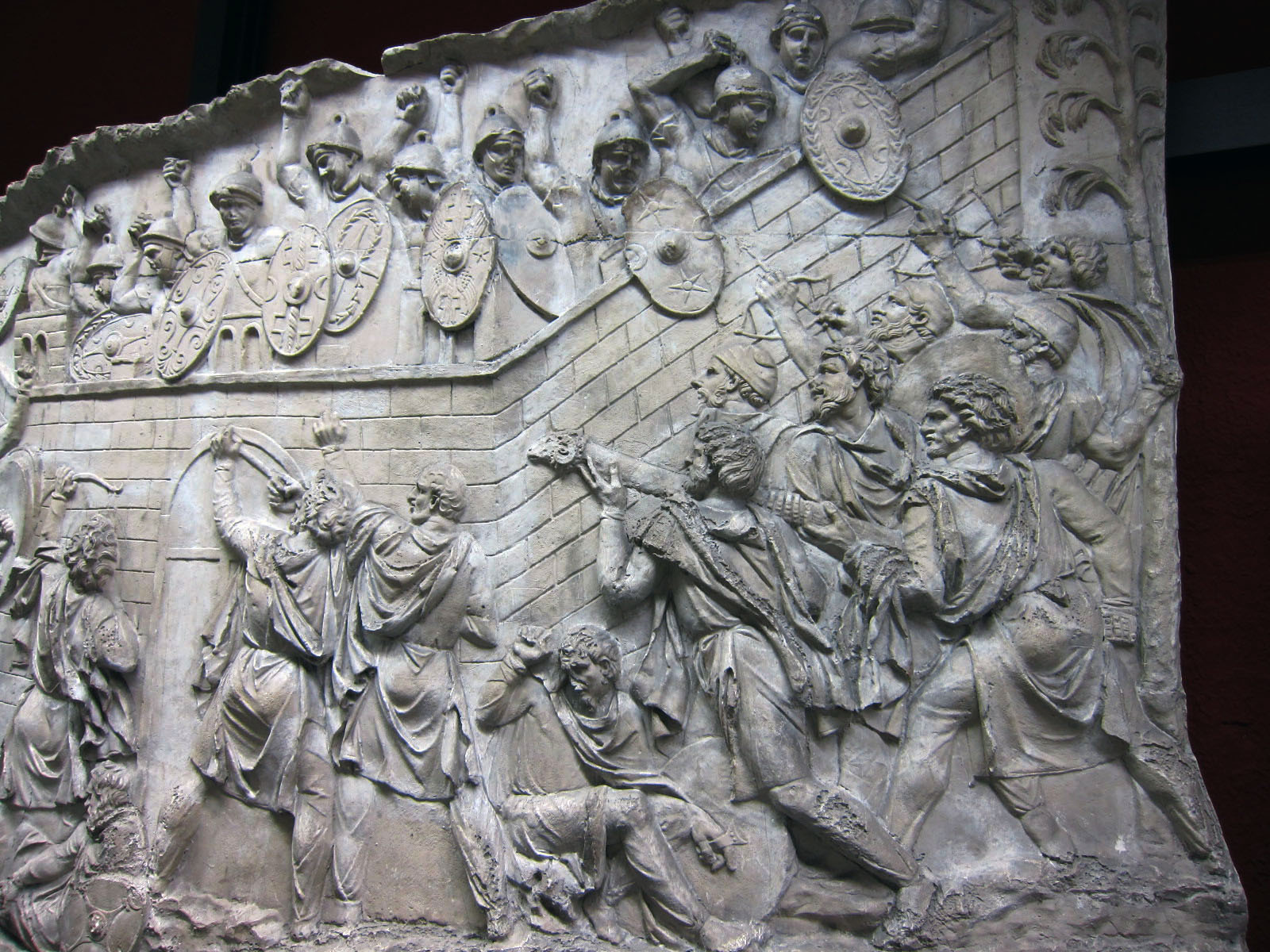 Another of the grand halls of the Museo della civilta Roma is filled with plaster casts of Trajan’s Column. It’s almost as if they took the column and unrolled it.
Another of the grand halls of the Museo della civilta Roma is filled with plaster casts of Trajan’s Column. It’s almost as if they took the column and unrolled it.
Standing under the column in Trajan’s Forum it’s very difficult to see what’s going on with the detail but here at the Museo, the whole history is laid out with explanations in Italian and English.
This is the story of how the Emperor Trajan and his troops kicked Dacian butt (modern day Romania) in two wars from 101-102 and again in 105-107.
The story begins with the Romans getting into their boats and crossing the Danube River. After building forts and a few small skirmishes, the war finally begins and it’s a brutal war. There are many panels of Roman soldiers riding fiercely into the fray, collecting heads of Dacian warriors to bring back to Trajan. In one scene, a soldier holds a severed head in his mouth as he continues to attack the Dacian horde.
The two wars are separated by a panel of the winged victory standing next to Trajan, but peace doesn’t last very long and soon the Romans are back across the Danube.
As the story ends, Decebalus, the Dacian King, commits suicide rather than be caught and ridiculed and killed in a Roman triumphal parade in Rome.
From EUR to Saint Paul’s (San Paolo Fuori Le Mura) outside the walls.
The Metro Blue line also stops at the Basilica of Saint Paul, the other great Saint of Rome. Peter and Paul are kind of like the Christian version of ancient Rome’s Romulus and Remus.
 Saint Paul’s is one of the 4 great basilicas of Rome along with Santa Maria Maggiore, San Giovanni in Laterano and San Pietro. It was built in the 4th century and is very true to the Roman basilica architectural style of a long nave with colonnades on each side.
Saint Paul’s is one of the 4 great basilicas of Rome along with Santa Maria Maggiore, San Giovanni in Laterano and San Pietro. It was built in the 4th century and is very true to the Roman basilica architectural style of a long nave with colonnades on each side.
The church was consecrated over the grave of Saint Paul. Oddly enough no one really knows how Paul died. There is no biblical or historical record. The church created the story that he was beheaded under the reign of Nero. And why not? It makes a good story and after-all he is one of the patron saints of the city. He deserves a good martyred death.
His sarcophagus is very visible from inside the church. You can see the holes made into the tomb used by Pilgrims to insert cloth and take away the holy essence. In 2009, the tomb was probed. The findings included bits of linen, incense and a small bone fragments, all dated from the 1st or 2nd century. The church was satisfied that it was the remains of Paul.
Saint Paul’s was preserved in its original state for over 1430 years until 1823, when a workman was repairing the roof. The flame he was using to melt lead accidently ignited the church. It pretty much destroyed most of it.
The 432 ft. long nave with four aisles is the original design, but the only original features of the 5th century Basilica are the triumphal arch with mosaics. The mosaics from the Apse were also saved but they are from the 13th century.
Making another stop along the Metro Blue line, we exited at Piramide, where the Pyramid of Gaius Cestius meets the Aurelian Wall at the Porta San Paolo. In 18 BC when the Pyramid was constructed, funeral tombs were not allowed inside the city walls, but crafty Cestius, a city magistrate, managed to buy the real estate immediately outside of the old Servian Wall. By the time the 4th century Aurelian Wall, Rome had grown considerably and thankfully for us, the city wall builders decided they liked the Pyramid and just incorporated it into the wall.
On the other side of the Pyramid of Cestius is the Protestant Cemetery of Rome, also known as the Cemetery of Non Catholic and Foreigners.
It is also know as the English Cemetery even though it’s also packed with Germans, Americans and Russians.
The cemetery is supported by donations from the non-catholic community and the visitors. Entrance is free but there are donation boxes for the care of the cemetery as well as the care of the cats of Rome.
It’s been so hot during the day that the cats have become nocturnal. Largo Argentina is cat free during the day but they all come out at night. There are still lots of them.
Agencies like the AISPA (Anglo-Italian Society for the Protection of animals) have provided food, shelter and sterilization.
Amongst the famous, and most sought after Eternal Markers here are John Keats (who died at age 26 of tuberculosis), Percy Bysshe Shelley (who drowned at age 29 off the Ligurian coast of Italy) and 19th century Russian neoclassical painter Karl Briuloff.
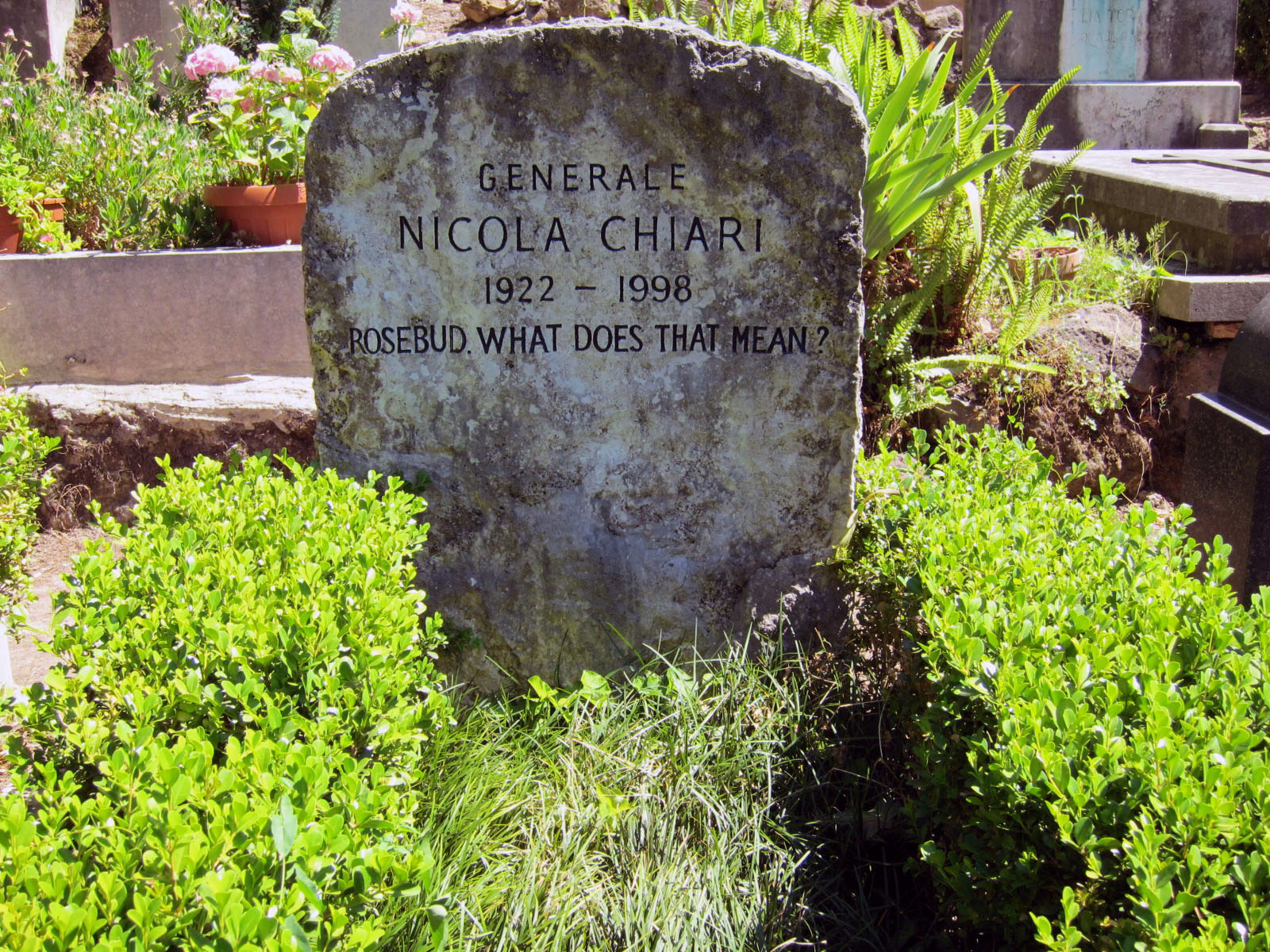 When the American Beat poet Gregory Corso died in 2001, his friends petitioned the cemetery and the city of Rome to let him be buried in his chosen destination. They succeeded.
When the American Beat poet Gregory Corso died in 2001, his friends petitioned the cemetery and the city of Rome to let him be buried in his chosen destination. They succeeded.
Gregory now lies at the foot the grave marker of Percy Bysshe Shelley. On his grave marker is the most beautiful epitaph I have ever read: Spirit is Life It flows through the death of me endlessly like a river unafraid of becoming the sea.
However, with all the wonderful grave markers and all the famous stranieri of Rome, the strangest grave marker of all has to go to one General Nicola Chiari who died in 1998.
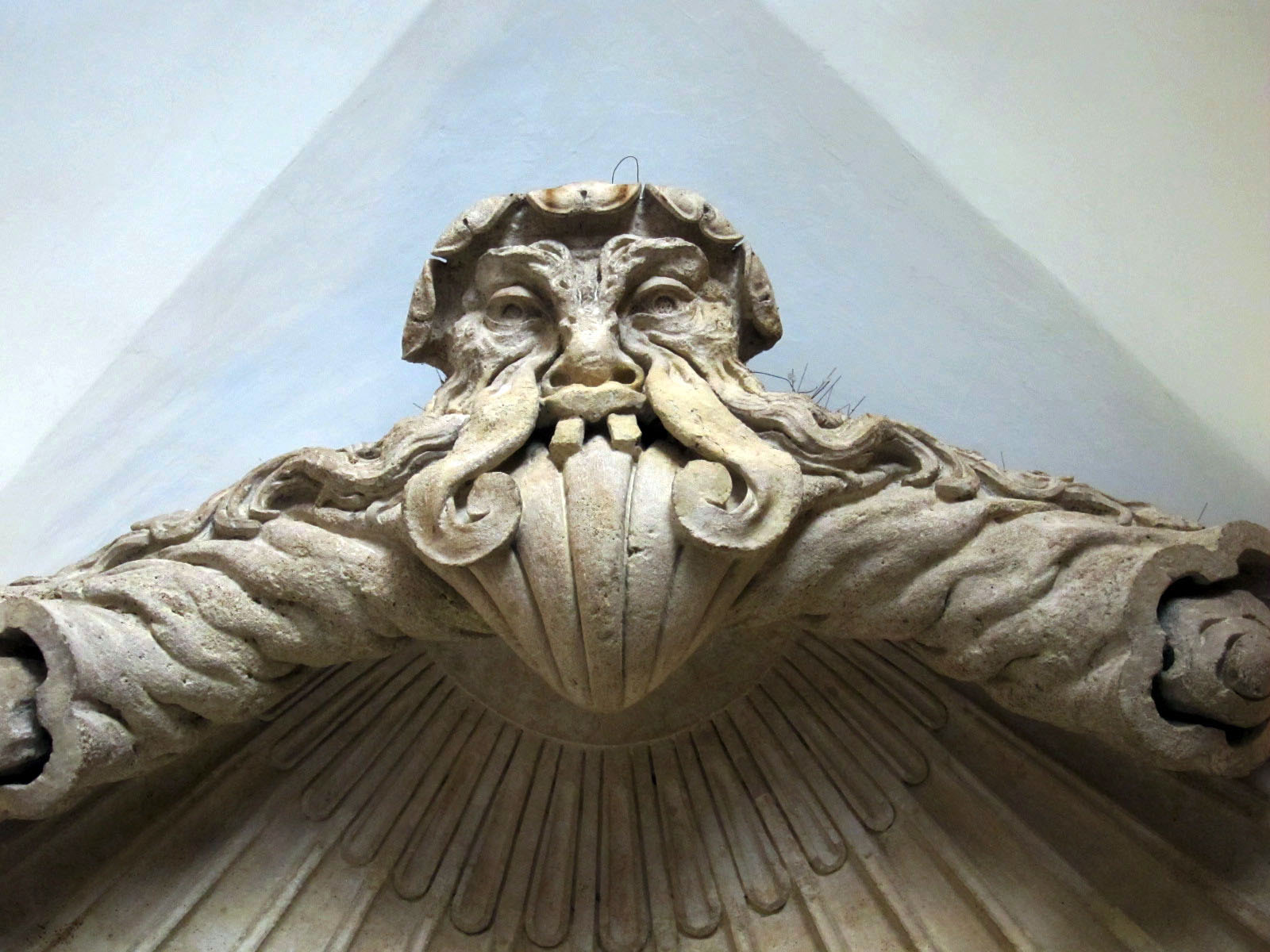 The Capitoline Museums are built over the Temple of Jupiter Optimus Maximus, another of the achievements of the last Roman King, Tarquinius Superbus after he leveled off the top of the Tarpeian Rock. Even with the rock leveled off for the temple, it was still high enough to use as an execution site all the way through the Roman republic, tossing murderers and traitors to their death below. Looking at the rock these days it doesn’t seem like the fall would cause more than a broken leg or a twisted ankle.
The Capitoline Museums are built over the Temple of Jupiter Optimus Maximus, another of the achievements of the last Roman King, Tarquinius Superbus after he leveled off the top of the Tarpeian Rock. Even with the rock leveled off for the temple, it was still high enough to use as an execution site all the way through the Roman republic, tossing murderers and traitors to their death below. Looking at the rock these days it doesn’t seem like the fall would cause more than a broken leg or a twisted ankle.
One of the great stories of the Temple construction is that during the first phase of the work, the workmen found a severed head, blood still flowing from it. The Auguri (Religious fortune tellers) decided this all meant that the Temple built here would surely become the head of Italy and the World, the Capitoline.
The foundations of the Temple are visible in the subterranean level of the museum but not much else survived.
We always enjoy this museum. Not only is the collection great, you also get to stand in the Tabularium, the 78 BC Hall of Records and have a fabulous view over the Forum.
This visit to the Capitoline was for the Lux in Arcana exhibit, 100 documents from the secret archives of the Vatican.
We spent over 4hrs in the exhibit and it seemed like only an hour passed by.
There were letters to the Pope from Abraham Lincoln and Jefferson Davis (in the same display). There was a letter from Lucrezia Borgia to her father, a letter from Marie Antoinette to her brother-in-law, the last letter ever written by Mary Stuart before she was beheaded. There was a letter from Michelangelo asking for money to pay his workmen, a petition from the English Parliament asking the Pope to annul the marriage of Henry VIII to Catherine of Aragon. There was a proclamation from Napoleon giving people of Rome the freedom to worship whoever they wanted after he claimed the city. There were letters from Voltaire, Empress “Sissi” Elizabeth of Austria. We saw a bill from Bernini for the marble used to create two of the statues for the Ponte Sant’Angelo. There was a chronicle of the trial of Galileo and the concession of Holy Roman Emperor Frederick I Barbarossa. And that’s just the short list. It was one of the best historical exhibits of old documents we have ever seen.
We made an attempt to see all 13 of the obelisks in Rome.
There are 8 ancient Egyptian obelisks and 5 ancient roman copies.
In 1586, Pope Sixtus V (Felice Peretti) hired the Swiss born architect Domenico Fontana (age 23 at the time) to move the obelisk in the Circus of Caligula a short distance away so it would be centered on the doorway of the new Basilica. Through an elaborate system of pullies, scaffold, 900 men and 75 horses they lowered and raised the 40 ton piece of granite into it’s new locations. It’s not quite centered but there was no way they were going to take it down and reset it again.
Sixtus V was so proud of this new Obelisk street marker that he had crews digging up more of them to place around the city and under the engineering stewardship of Domenico Fontana he installed the Obelisks at the Basilicas of St John in Lateran and Santa Maria Maggiore in 1587 the one in Piazza del Popolo in 1589.
Basilica of Saint John in Lateran (in the Piazza in front of the Basilica) is from the temple of Amun in Karnac and was rediscovered buried in Circus Maximus
Basilica of Saint Peter (the Vatican Needle in the front of the Basilica) is from Lilium in Alexandria and was moved just a few feet from where it was originally erected in the Circus of Caligula.
Piazza del Popolo (the photo above) came from Heliopolis and was buried in Circus Maximus
Piazza do Montecitorio (the close up detail in the photo above) is in front of the Palazzo Montecitorio (current Hall of Deputies) off the via del Corso. It was from Heliopolis and found in Campus Martius.
Piazza della Rotonda (in front of the Pantheon) was from the temple of Ra in Heliopolis, found near Piazza Colona
Santa Maria Sopra Minerva was from Sais and was found near the Temple of Isis which used to be the same spot as the present day church. It now sits on top of the Bernini Elephant known as Pulcino della Minerva.
Baths of Diocletian (near Termini train station) was one of a pair from Heliopolis. The other is in the Boboli gardens in Florence. Found near temple of Isis
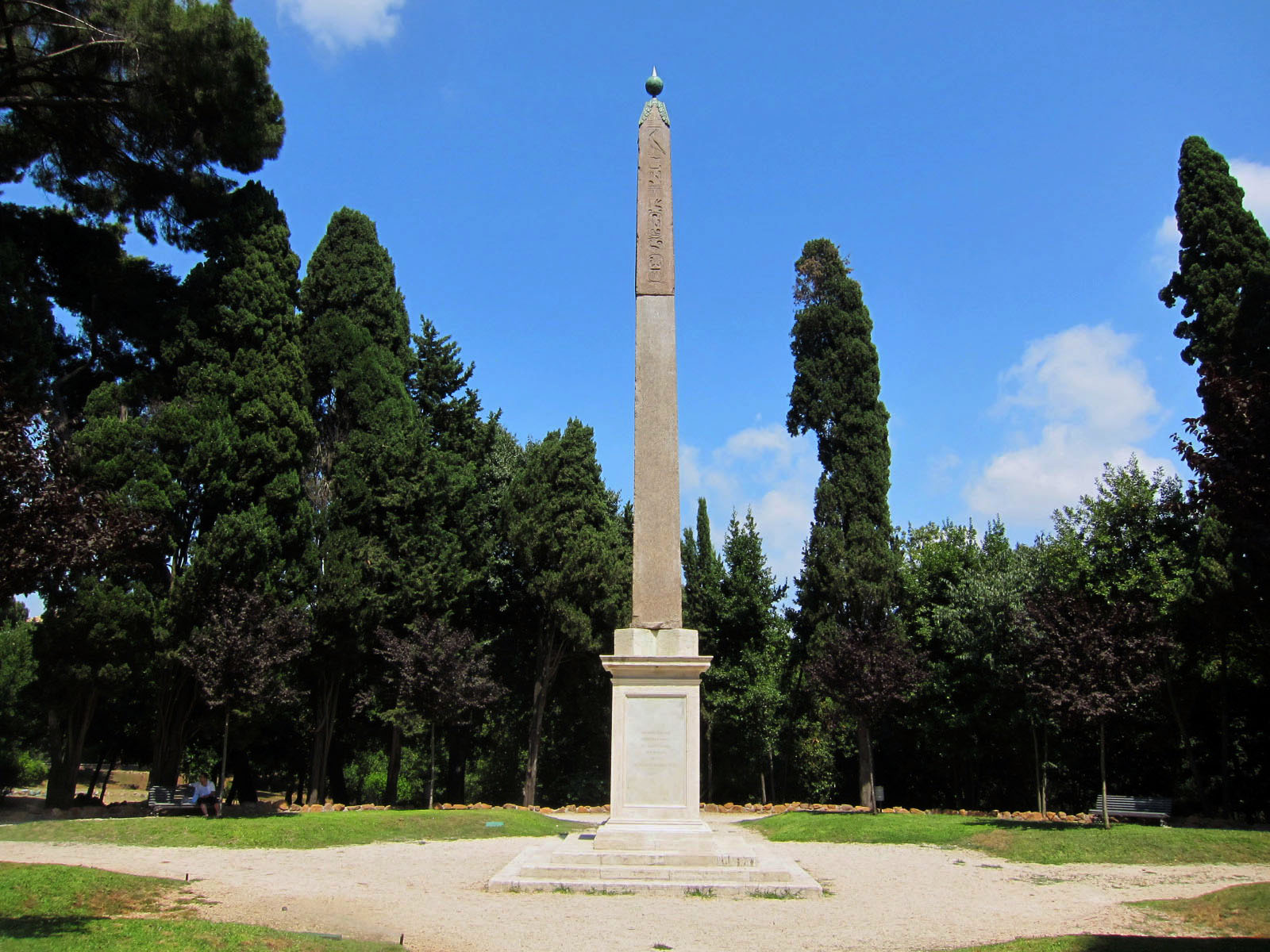 Villa Celimontana (photo left) is one of the hardest ones to find. It’s in the park on the Celian Hill across from the Colosseum and the Palatine. It was once rumored that the ashes of Augustus were sealed in the globe at the top but not true. The top of the obelisk was from the temple of Ra in Heliopolis. It was found near the temple of Isis (now the church of Santa Maria Sopra Minerva). No one really knows where the bottom half came from but probably a roman copy.
Villa Celimontana (photo left) is one of the hardest ones to find. It’s in the park on the Celian Hill across from the Colosseum and the Palatine. It was once rumored that the ashes of Augustus were sealed in the globe at the top but not true. The top of the obelisk was from the temple of Ra in Heliopolis. It was found near the temple of Isis (now the church of Santa Maria Sopra Minerva). No one really knows where the bottom half came from but probably a roman copy.
The (5) Roman obelisks:
Piazza Navona (on top of Bernini’s “Four rivers” fountain) was commissioned by Domitian for the temple of Serapis. Moved from the Circus of Maxentius on the Appian Way
Piazza Quirnale (in the Piazza Quirinale flanked on either side by the ancient Greek horse tamer statues) is near the Quirinale Palace came from the Mausoleum of Augustus
Basilica of Santa Maria Maggiore (in the Piazza in front of the Basilica) is also from the Mausoleum of Augustus
Trinita dei Monti is above the Spanish Steps was commissioned by the Emperor Aurelian
Pincian Hill is in the Villa Borghese park was commissioned by Hadrian and erected in Tivoli for the tomb of Antinous.
A Day Trip to Orbetello
The best part of having a month in any city is that you have time to relax. You don’t feel like you have to jump up every morning and pound the streets till dark. Some days you can just sit on the terrace and watch the people go by, or hang out in a café or walk to a nice Osteria for a long lunch or just offer directions to tourists staring lost into large maps of Rome.
When it got too hot in the city, we to the metro over to one of the train stations and got out of town for a couple of Day Trips. The first was a 2hr train to the small city of Orbetello, a small peninsula south of Grosetto in Tuscany that connects to the island of Monte Argentario. The town is surrounded by natural wildlife preserves. The 5th century BC city walls are still there.
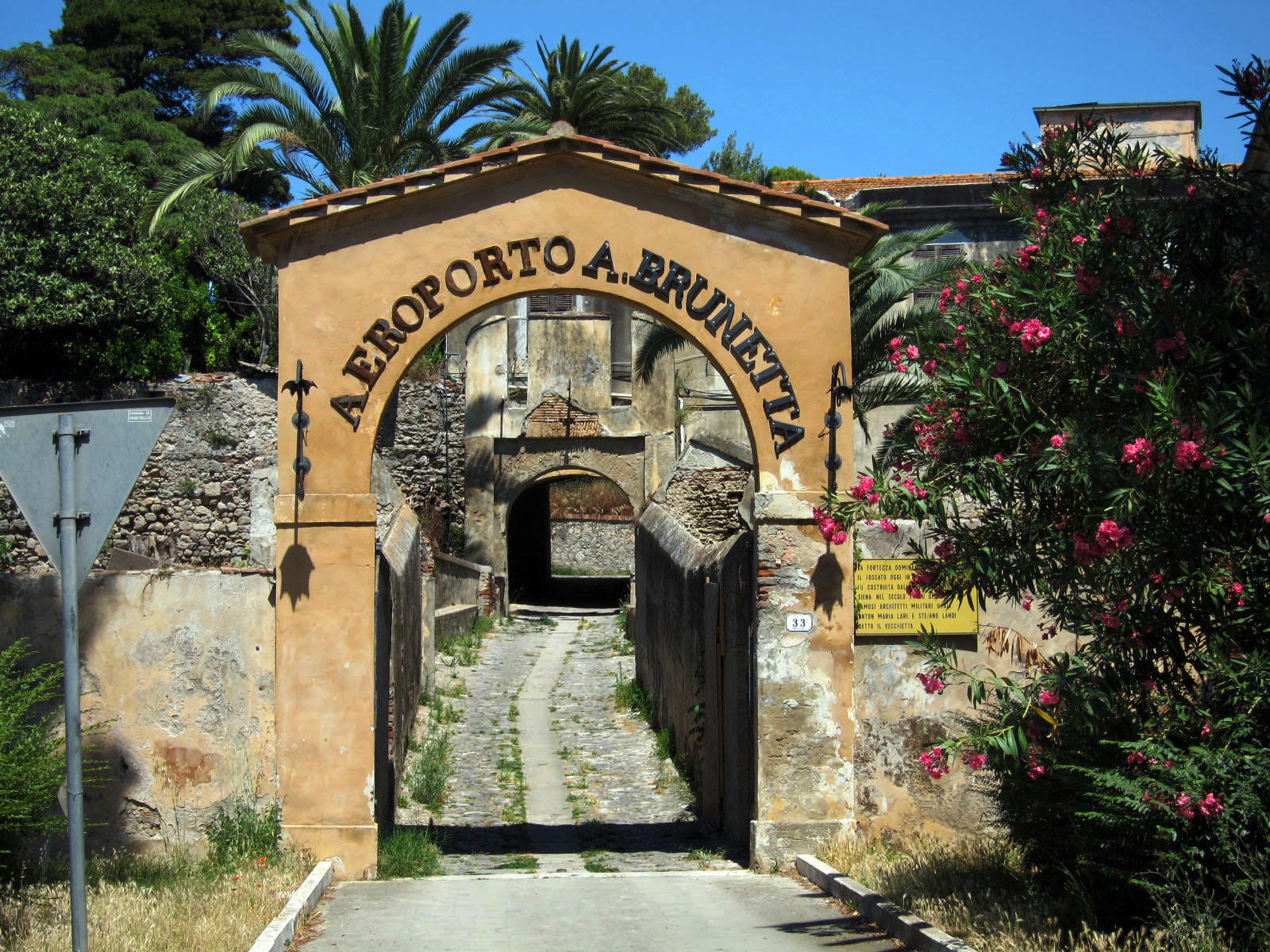 In 1930, Italo Balbo (Mussolini’s top commander) led the first transatlantic crossing of a squadron of 12 planes from here and landed on Lake Michigan. Balbo Drive still exists in Chicago very close to the Lake Front. In the 30’s and 40’s a squadron of planes in formation was known as a “Balbo”. The Sioux Indians even adopted him and called him “Chief Flying Eagle”.
In 1930, Italo Balbo (Mussolini’s top commander) led the first transatlantic crossing of a squadron of 12 planes from here and landed on Lake Michigan. Balbo Drive still exists in Chicago very close to the Lake Front. In the 30’s and 40’s a squadron of planes in formation was known as a “Balbo”. The Sioux Indians even adopted him and called him “Chief Flying Eagle”.
The train station is a 45 minute walk into town but it’s a really beautiful walk. And after a nice walk around town and a delicious fresh seafood lunch we got back on the train and relaxed for another 2hrs back to Rome.
It’s a quiet little town, or maybe it was just waiting for the summer holiday to begin in a couple of weeks.
Viterbo
Our second day trip was another 2hr train trip to the medieval mountain town of Viterbo. When the train stopped in Bracciano I remarked to Gretchen, “Hey, this is where Tom Cruise and Katie Holmes got married about 5 years ago”. When we got back to Rome we read they were about to get divorced. So it goes.
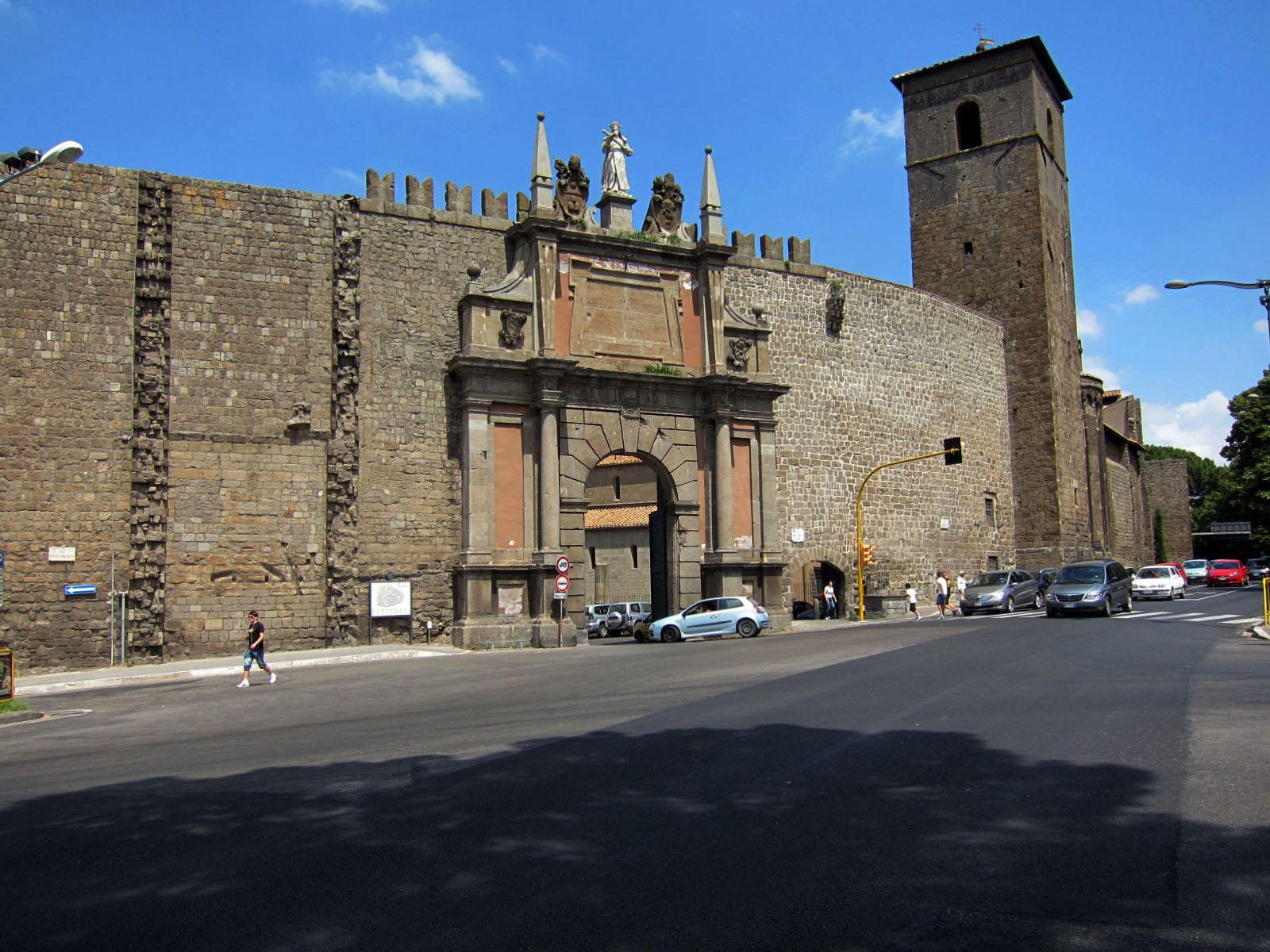 Viterbo has a beautiful medieval wall around much of the city but you have to walk pretty far into it to get to the old town. Much of it goes back to the 12th century. There are ancient streets, ancient churches, the ancient Palazzo dei Papi, and a few ancient roman ruins. It’s pretty ancient.
Viterbo has a beautiful medieval wall around much of the city but you have to walk pretty far into it to get to the old town. Much of it goes back to the 12th century. There are ancient streets, ancient churches, the ancient Palazzo dei Papi, and a few ancient roman ruins. It’s pretty ancient.
We even ran into a museum exhibit of the ancient Chinese clay soldiers from the Qin dynasty in an old courthouse. The curator of the exhibit told us the courthouse was famous in the 1950s for prosecuting and convicting Gaspare Pisciotta, the close friend of the infamous Sicilian bandit Salvatore Giuliano and one of the most famous criminals in Italian history. He was tried for many crimes including the Massacre at Portella della Ginestra when 11 people were killed and 27 wounded during a May Day celebration in 1947.
Pisciotta also admitted that he killed Giuliano in his sleep on orders from the Minister of the Interior, but it didn’t help his cause. He was convicted along with close to 70 others of the Giuliano gang, locked up inside the Viterbo prison that still casts an ominous shadow just outside of the old walls.
In 1954, he took 20mg of strychnine disguised as a vitamin pill. He died 4 hrs. later.
The town was getting ready for an annual food festival that started the next day so most of the restaurants were closed but we found a good one and had a great lunch before hopping on the train and taking the 2hr trip back to Rome.
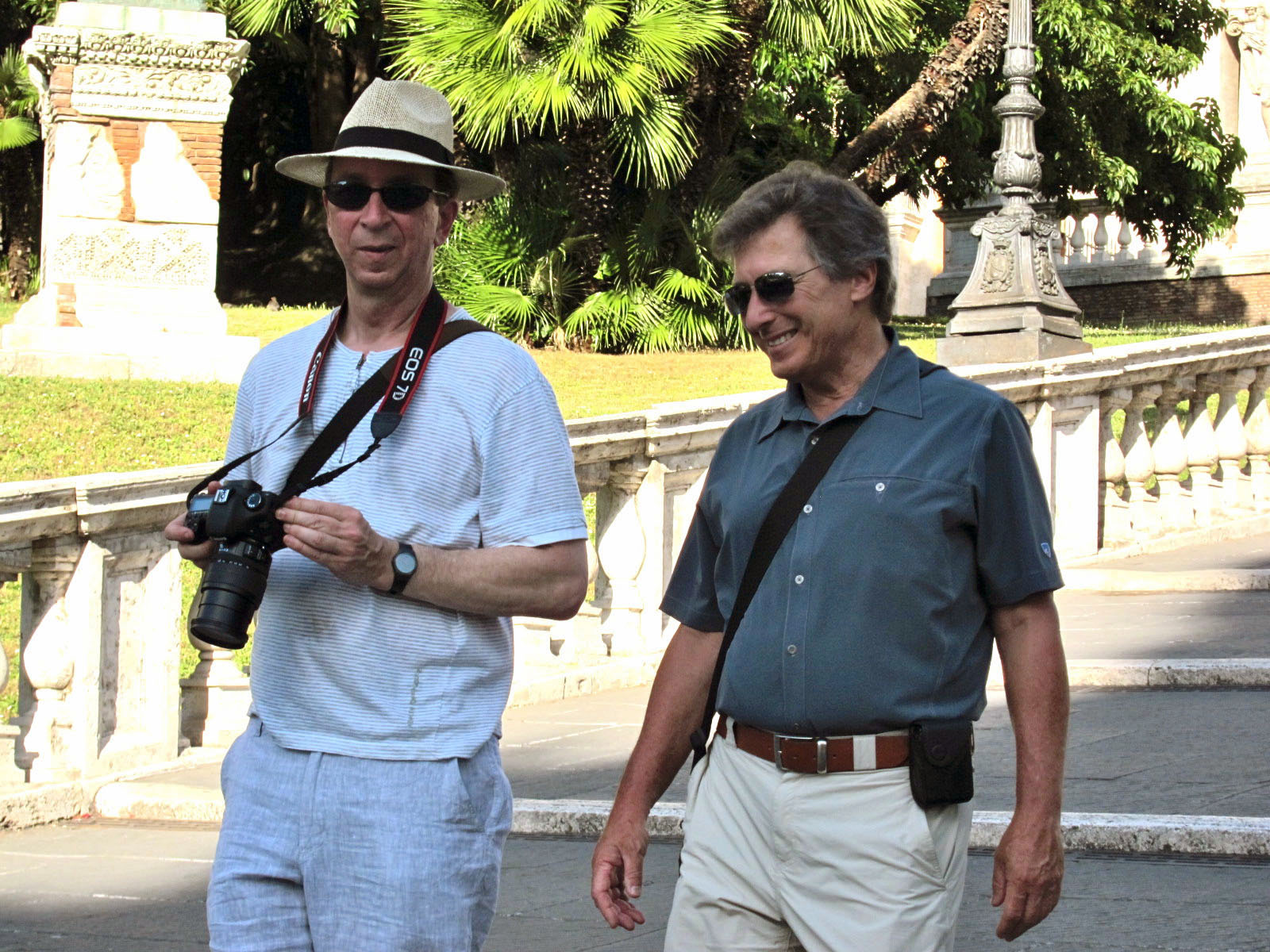 Rome is such a great destination that if you stay here long enough you’re bound to run into a friend or two.
Rome is such a great destination that if you stay here long enough you’re bound to run into a friend or two.
Our San Francisco friend Bill, who was at his apartment in Paris came over for a few days before returning back to the States.
Our friend Michelle with her husband Stefan and two kids, Elizabeth and Christopher came over for a 5 day tour of Rome and got caught in the intense heat. It took them a couple of days to acclimate, and find a good pizzeria, but they had a great time. Almost every restaurant in Rome offers pizza but you soon learn where the good ones are.
And Paola, our friend from Lastra A Signa (near Florence) came down for a day visit. We had lunch at Roscioli’s in Campo dei Fiori, took in the Basilica of San Clemente and shopped till we dropped from the Spanish Steps to Piazza Navona to the Piazza Montecitrio near the Italian Chamber of Deputies.
There is always something going on in the Eternal city.
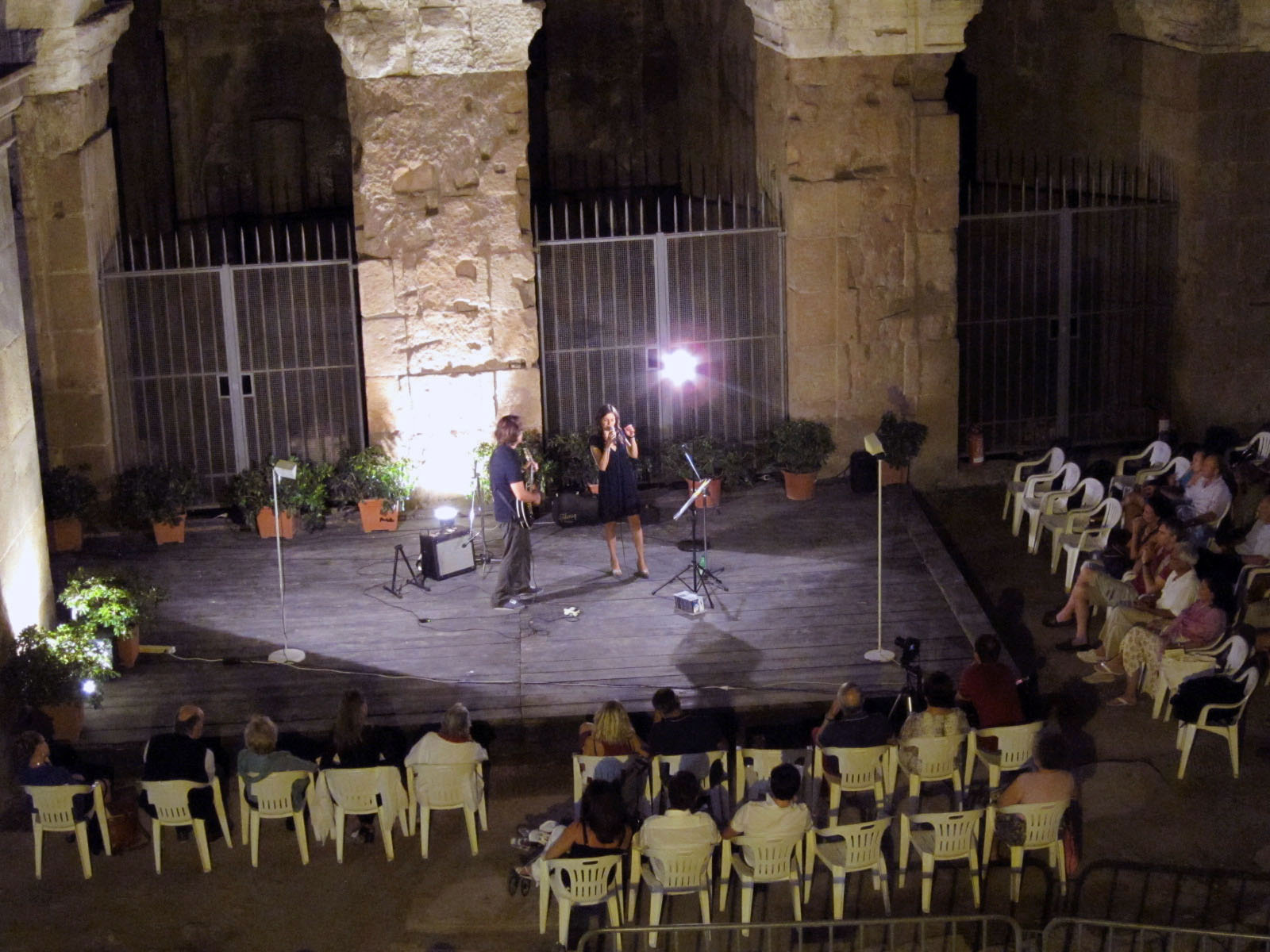 We saw the fireworks on the festival of Peter and Paul, the outdoor concert series at the Teatro Marcello, the film festival on Tiburtina island, the All’Ombra del Colosseo food and theatre festival on the Celian Hill, the ballet and Opera season at the Baths of Caracalla, some of the music performances set up in every major Piazza on the summer solstice, the crowds of flag waving football fans crossing the Piazza del Colosseo on their way to the Circus Maximus to watch the large screen projection of the EUFI playoff match of the European Football Championship of Italy vs. Spain. Close to 60,000 Romans packed into the old racetrack to watch their team get totally whooped.
We saw the fireworks on the festival of Peter and Paul, the outdoor concert series at the Teatro Marcello, the film festival on Tiburtina island, the All’Ombra del Colosseo food and theatre festival on the Celian Hill, the ballet and Opera season at the Baths of Caracalla, some of the music performances set up in every major Piazza on the summer solstice, the crowds of flag waving football fans crossing the Piazza del Colosseo on their way to the Circus Maximus to watch the large screen projection of the EUFI playoff match of the European Football Championship of Italy vs. Spain. Close to 60,000 Romans packed into the old racetrack to watch their team get totally whooped.
Roman time is different from anywhere else. It always has been. The ancients copied the sense of time from the Greeks, dividing the day into hours.
In those days the Romans divided the day into 12 hours from dawn to dusk. The length of the hours would change according to the seasons. On Dec 21st, the shortest day of the year, an hour was equivalent to 45 minutes while during the summer it could increase to 75 minutes.
The clocks (which only had hour hands) had to be adjusted every two weeks to account for the sun’s course. Even while mechanical clocks were changing throughout the rest of Europe, gaging an hour to a defined 60 minutes, the clocks in Rome kept their own time, all the way up to 1808, when Napoleon invaded the city.
Most of the clocks work alongside the rest of Europe, well, maybe not all of them. Rome still enjoys a little discrepancy on setting their clocks. The train station clocks are slightly different that the bank clocks or the church clocks. The water clock in the Villa Borghese is 15 minutes fast and even though the shop windows tell you the shop is open at 09:30 you could easily wait till 10:30.
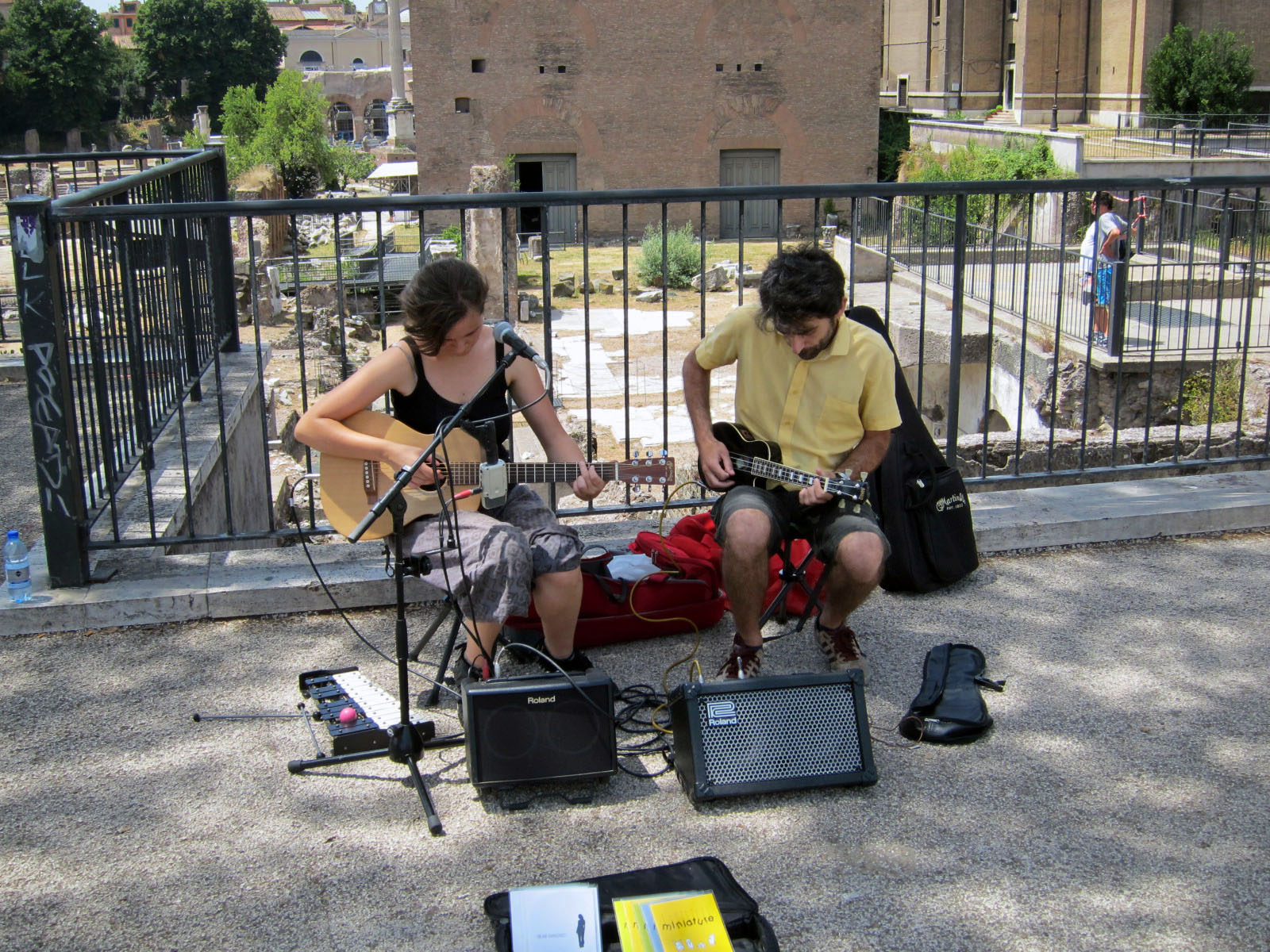
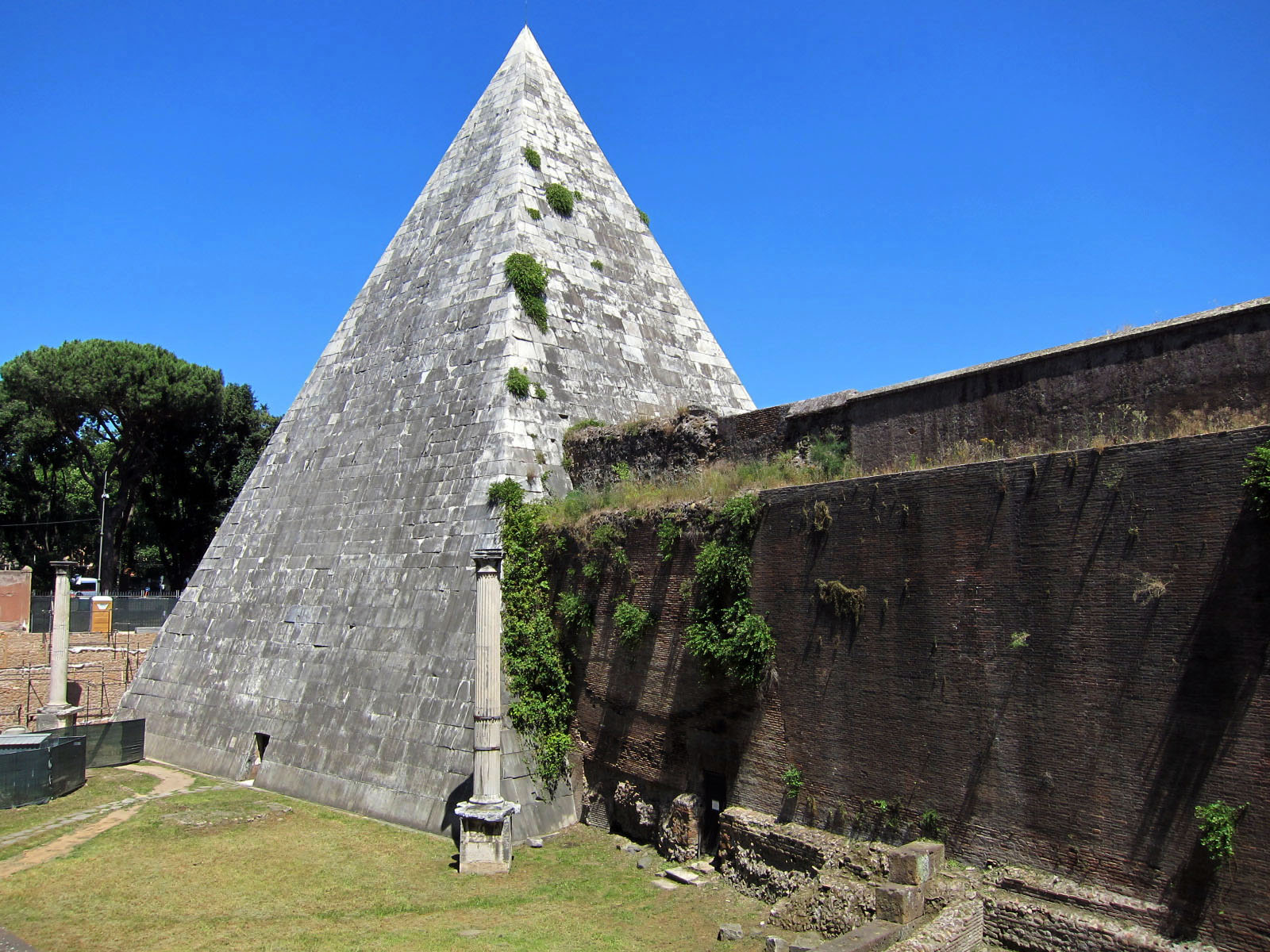
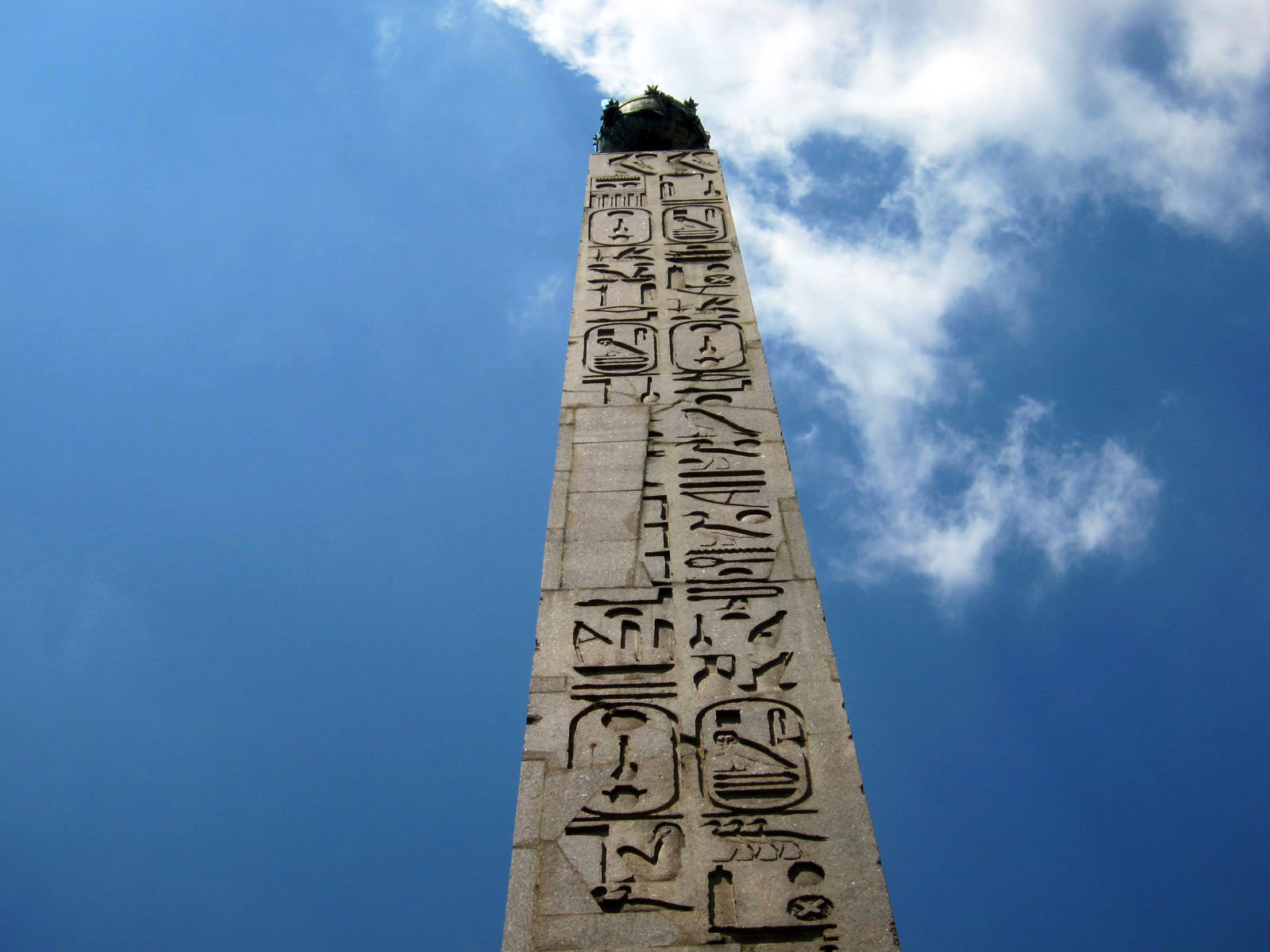
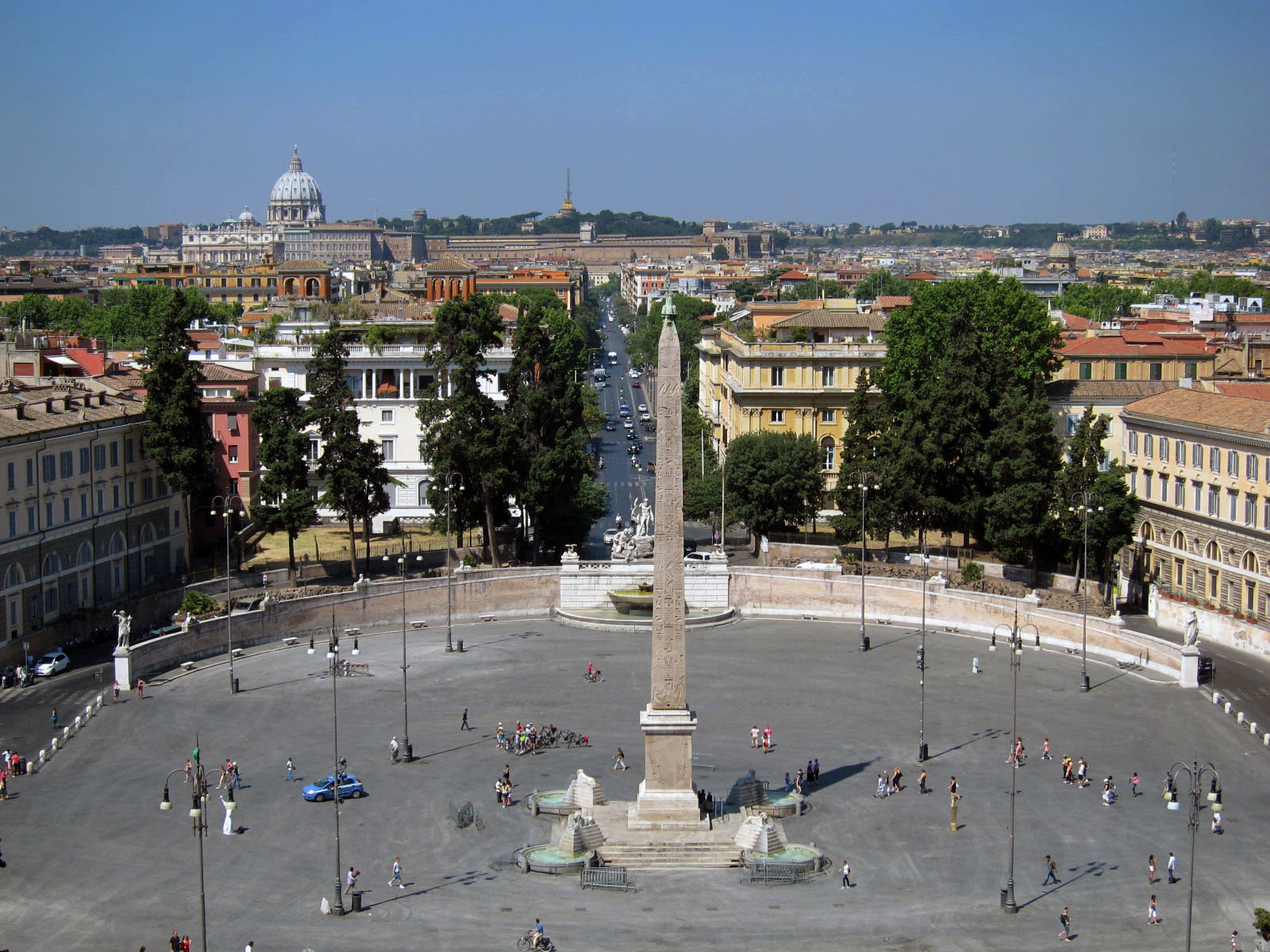

You must be logged in to post a comment.